 |
| In the Adventures of Buck Danny placed during the 40s a large quantity of aircraft involved in WW II operations are shown. Mostly of these are US Navy or US Army Aviation aircraft even if several Japanese and some British and Russian models are also present. |
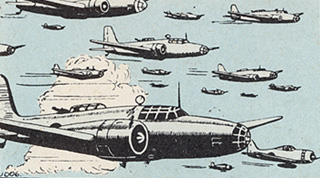
| In the story LES JAPS ATTAQUENT the first aircraft shown are a group of Japanese bomber Mitsubishi Ki-21. These bombers are depicted during the Japanese attack to Pearl Harbour on December the 7th 1941. This is one of the mistake present in this story because in the reality these bombers have not been used in the Pearl Harbour attack. |
Some Mitsubishi Ki-21 are also involved in a massive bombig activity in the story LA REVANCHE DES FILS DU CIEL. In this adventure the graphic representation of the aircraft is much more accurate respect to the first story. |
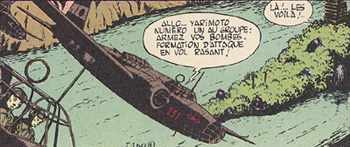 |
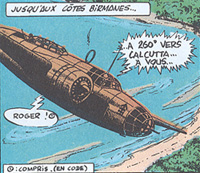
| 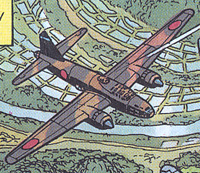
| Another representations of a Japanese Mitsubishi Ki-21 is present in the stories LES TIGRES VOLANTS and THE MASCOTTE. The Mitsubishi Ki-21 (Allied codename: "Sally" /"Gwen") was a Japanese bomber during World War II. It began operations during the Second Sino-Japanese War participating in the Nomonhan Incident, and in the first stages of the Pacific War, including the Malayan, Burmese, Dutch East Indies and New Guinea Campaigns. It was also used to attack targets as far-flung as western China, India and northern Australia. |
The Mitsubishi Ki-21 had a crew of 5-7 it was armed with 5 × 7.7 mm flexible Type 89 machine guns in nose, tail, beam and tail positions.
1 × 12.7 mm Type 1 Heavy Machine Gun in dorsal turret and it could carried up to 1000 kg (2200 lb) of bombs. Several improved versions of the Ki-21 have been manufacured before the production of the type ended in September 1944. A total of 2,064 aircraft were built, 1,713 by Mitsubishi and 351 by Nakajima.
|
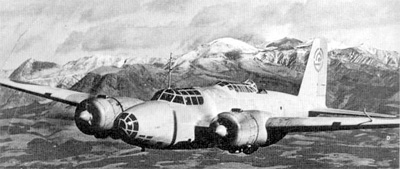 |
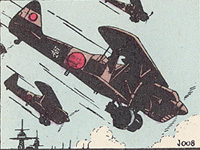 |
In the story LES JAPS ATTAQUENT also a Kawasaki Ki-3 is shown as part of the airplanes attacking Pearl Harbour. This is another incongruence because the old Ki-3 actually was not used over Pearl Harbour |
A group of Ki-3 are also shown in the story LES MYSTERES DE MIDWAY. These biplanes are depicted in the scene of the Midway island attack even if in the reality these airplanes have never been used during the Midway battle.
|
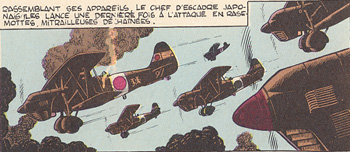 |
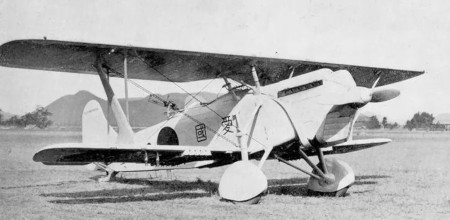 |
The Kawasaki Ki-3 was a light bomber built by Kawasaki for the Imperial Japanese Army in the 1930s. It was the last biplane bomber design to be produced for the Imperial Japanese Army Air Force, and saw combat service in Manchukuo and in north China during the early stages of the Second Sino-Japanese War.
|
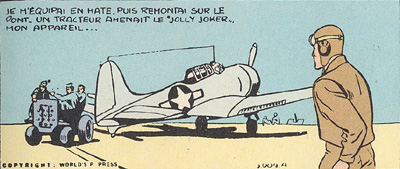 |
In the story LES JAPS ATTAQUENT the first aircrat used by Buck Danny was a Douglas SBD Dauntless on board of a not specified aircraft carrier more likely the USS Yorktown.In this story there is a little confusion about Buck Danny's exact enlistment, in fact he seems to be enlisted as a Captain of the US Army Aviation but he is actually on duty as a Naval Aviator flying US Navy aircraft on board of the aircraft carriers. |
Some Dauntless are also shown in the story LES MYSTERES DE MIDWAY involved in the Midway battles against the Imperial Japanese Navy. The Douglas SBD Dauntless was a naval dive bomber made by Douglas during World War II. The SBD was the United States Navy's main dive bomber from mid-1940 until late 1943, when it was supplanted, although not entirely replaced, by the SB2C Helldiver.
|
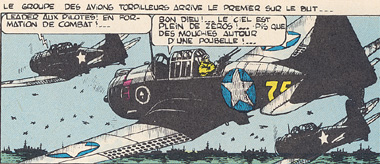 |
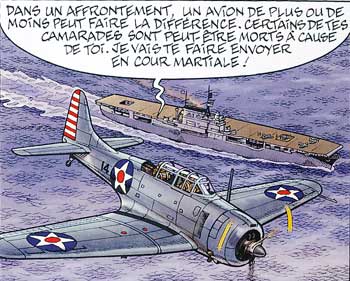 |
A Dauntless is also well represented by Bergese in the short adventure LE LACHE published as inedit story on the Les aventures de Buck Danny rècit complet special volume ALERTE NUCLÈAIRE. |
Some Dauntless are also represented by Marniquet in the short story L'INEVITABLE RENCONTRE published in 2017 as inedit story on the comic SPIROU #4108 dedicated to the 70th years of the Buck Danny adventures. |
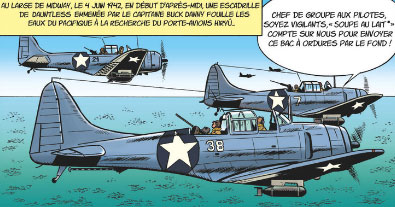 |
A Dauntless is also well depicted by De Luca in the short BUCK DANNY ORIGINS - LE PILOTE A L'AILE BRISEE published in 2022. |
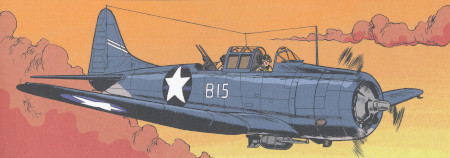 |
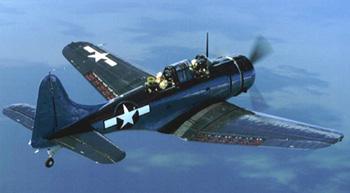 |
The SBD was involved in combat from the first day of the Pacific War, as Dauntlesses arriving at Hawaii from USS Enterprise were caught in the Pearl Harbor attack. However, the SBD's most important contribution to the American war effort probably came during the Battle of Midway (early June 1942), when SBD dive bomber attacks sank all four of the Japanese aircraft carriers, three of them in the space of just six minutes (the Akagi, Kaga, Soryu, and Hiryu) as well as heavily damaging two Japanese cruisers (including the Mikuma, which sank before a Japanese destroyer could scuttle it). |
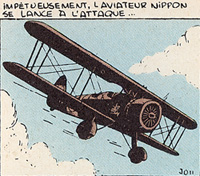 |
In the story LES JAPS ATTAQUENT Buck Danny engaged his first flight combat against some old japanese Navy biplane dive bomber Aichi D1A. During this first dog fight the Buck Danny's Dauntless entered in collision with one of the Aichi D1A and both the airlanes crashed. |
A group of Aichi D1A are also shown in the story LES MYSTERES DE MIDWAY. In reality these old biplane aircraft were not utilized during the Midway battle being the advanced variant Aichi D3A1 used during this battle.
|
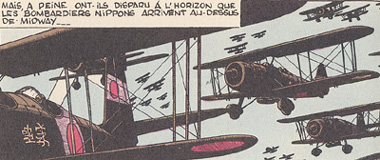 |
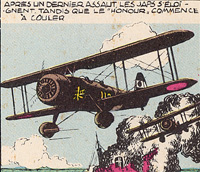 |
In the story LA REVANCHE DES FILS DU CIEL some dive bombers Aichi D1A attack and destroy the cargo ship used by Buck Danny and the other ":Flying tigers" members to reach their destination in China. The Aichi D1A (code named "Susie") was an early dive bomber produced by Aichi for the Imperial Japanese Navy. |
The D1A was primarily used in the Second Sino-Japanese War and up to the time Japan entered World War II in 1941, but few were actually used in combat. All of the remaining D1A1s were decommissioned and most of the D1A2s were retired from the front lines and served primarily as training units. The exception was 68 of the D1A2 model that operated as a second-line support until being retired in 1942. This biplane was armed with 2× fixed 7.7 mm (.303 in) Type 92 machine guns and
1× flexible 7.7 mm (.303 in) Type 92 machine gun.
|
| 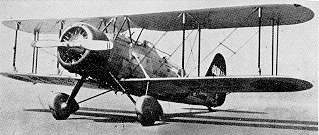 |
|
Fantasy japanese aircraft |
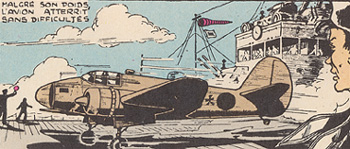 |
In the story LES JAPS ATTAQUENT Buck Danny and the two crew member of his Dauntless were able to stole a japanese bomber. This aircraft being not well represented, for some elements it seems a mix of the transport aircraft Gasuden TR.2 and the Mitsubishi Hinazuru based on the British Airspeed AS.6 Envoy.
|
The Gasuden TR.2 was a revised and strengthened design of the Hitachi TR.1 small airliner with a larger wing area, and main undercarriage that only semi-retracted. Twelve examples were built in a small series, but performance was not as good as the TR.1, since the modifications to the design had added 260 kg (570 lb) to the aircraft.
|
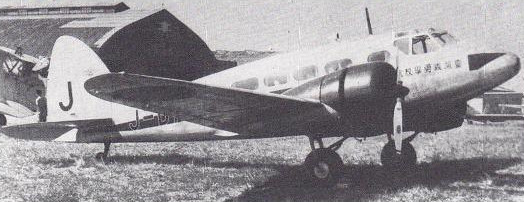 |
|
Nakajima Ki-49 Donryu "Helen" |
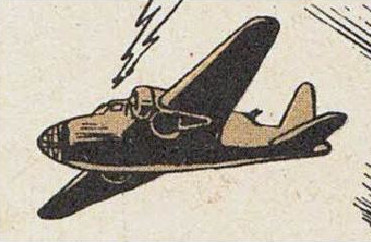 |
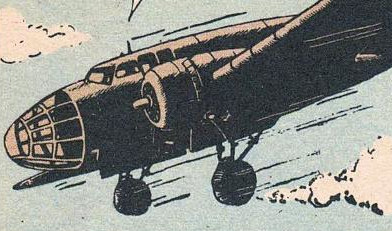 |
In some other drawings of the same story LES JAPS ATTAQUENT the stollen aircraft seems to be the japanese bomber Nakajima Ki-49 Donryu.
|
The Nakajima Ki-49 Donryu was a twin-engine Japanese World War II heavy bomber. It was designed to carry out daylight bombing missions, without the protection of escort fighters. Consequently, while its official designation, Army Type 100 Heavy Bomber, was accurate in regard to its formidable defensive armament and armor, these features restricted the Ki-49 to payloads comparable to those of lighter medium bombers – the initial production variant could carry only 1,000 kg (2,200 lb) of bombs.
|
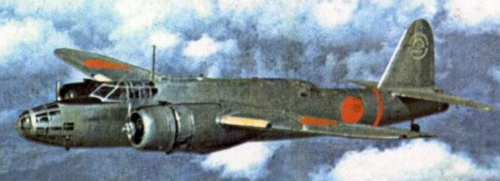 |
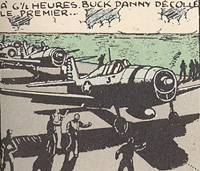 |
In the story LES JAPS ATTAQUENT the second aircrat used by Buck Danny was a Grumman F6F-3 Hellcat on board of the USS Yorktown. With this aircraft after a dangerous mission Buck Danny made an emergency (landing gear up) crash landing on the aircraft carrier. |
Buck Danny flies again on a Hellcat in the story LES MYSTERES DE MIDWAY. Some Hellcat seem to be also shown in the story LA REVANCHE DES FILS DU CIEL. The Grumman F6F Hellcat was a fighter aircraft descended from the earlier F4F Wildcat, but was a completely new design sharing only a familial resemblance to the Wildcat.
|
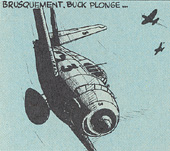 |
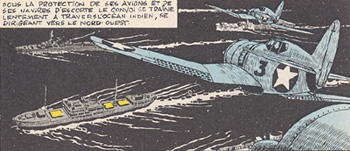 |
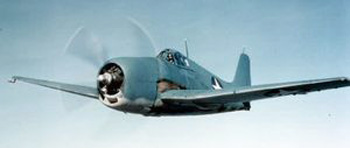 |
The Hellcat proved to be the most successful aircraft in naval history, destroying 5,171 aircraft while in service with the U.S. Navy and U.S. Marine Corps (5,163 in the Pacific and eight more during the invasion of Southern France), plus 52 with the Royal Navy's Fleet Air Arm during World War II. |
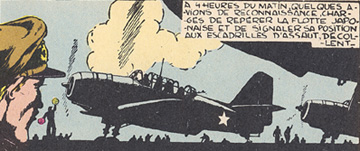 |
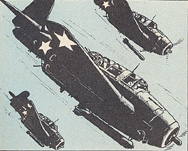 |
In the story LES JAPS ATTAQUENT and LES MYSTERES DE MIDWAY some US Navy torpedo bombers Grumman TBF Avenger are shown in action against the Japanese fleet. |
The Grumman TBF Avenger is also shown in a frame of the story LA REVANCHE DES FILS DU CIEL. In this images Buck Danny explain a possible method to pick up operatives behind enemy lines in areas from where an airplane can’t land. The earlier system use a pair of poles that were set in the ground on either side of the person to be retrieved, with a line running from the top of one pole to the other. An aircraft (usually a C-47 Skytrain) would trail a grappling hook and engage the line, which was attached to the person to be retrieved.
This early WW II concept was later improved with the introduction of the Fulton Surface-To Air-Recovery-System (STAR) or Skyhook (see also the page relevant to the aircraft of the 60s-70s in the section of the Hercules C-130) |
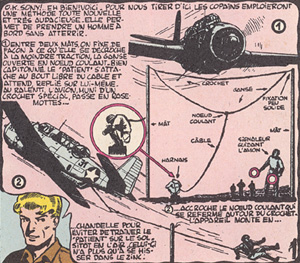 |
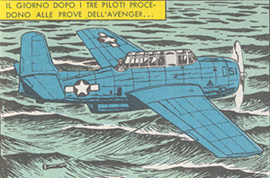 |
A restored Avenger was also used by Buck Danny and his friends in the story PATROUILLE A L'AUBE, where a criminal organisation lead by a former Nazi U-Boat commander abduct the three US Navy pilots and obligate them to find a WW II Nazi treasure lost in a sinked German submarine. |
The Grumman TBF Avenger (designated TBM for aircraft manufactured by General Motors) was a torpedo bomber developed initially for the United States Navy and Marine Corps, and eventually used by several air or naval arms around the world. It entered U.S. service in 1942, and first saw action during the Battle of Midway. This aircraft was heavy armed with 1 x 0.30 cal (7.62 mm) nose-mounted M1919 Browning machine gun (on early models)
2 x 0.50 cal (12.7 mm) wing-mounted M2 Browning machine guns
1 x 0.50 cal (12.7 mm) dorsal-mounted M2 Browning machine gun
1 x 0.30 cal (7.62 mm) ventral-mounted M1919 Browning machine gun
Up to 2,000 lb (907 kg) of bombs
1 × 2,000 lb (907 kg) Mark 13 torpedo
. |
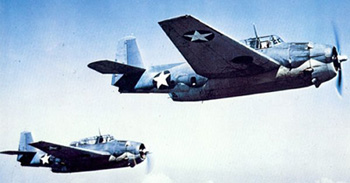 |
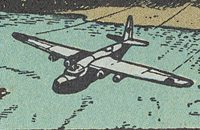 |
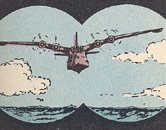 |
In the story LES JAPS ATTAQUENT a Japanese four engines seaplane is shown. Even if not clearly represented it could be intended as a Kawanishi H8K. |
In the story LES MYSTERES DE MIDWAY Buck Danny is rescued by a fantasy Japanese four engines flying boat. Also in this case this airplane could be intended as a Kawanishi H8K even if its fuselage general design remind much more the two engines US Navy flying boat Martin PBM Mariner .
|
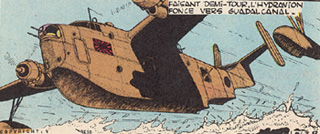 |
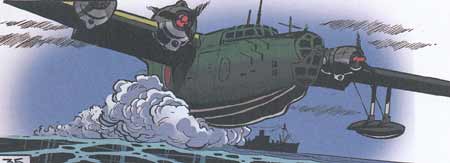 |
In the story LES FANTôMES DU SOLEIL LEVANT a Kawanishi H8K is also well represented by Arroyo. |
A group of Kawanishi H8K are well depicted In the story BUCK DANNY ORIGINS - LE PILOTE S L'AILE BRISEE.
|
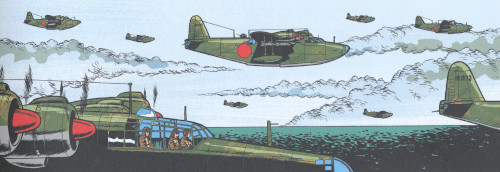 |
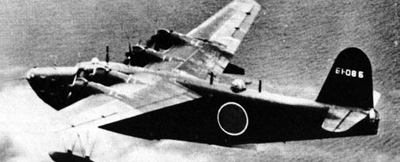 |
Designed in response to a 1938 specification for a replacement for the Kawanishi H6K, the result was the H8K. Comprising the single greatest leap in flying boat technology, the H8K was the most advanced flying boat of WWII and for many years after the war.
In service 24-hour long patrols were typical. In fact, their first sortie was to have been a bombing raid on Oahu, Hawaii, with a stop for refueling by submarine. The mission was aborted due to weather over the target.
|
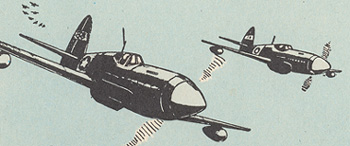 |
In the story LES JAPS ATTAQUENT a group of the first prototype version of the Curtiss P-40 Warhawk seem represented. This early version took the denomination of XP-40. |
The first prototype, XP-40, flew on October 14, 1938. Armament at this time was two 0.50-inch machine guns located in the upper fuselage deck and synchronized to fire through the propeller arc, standard armament for US pursuit aircraft at the time. Wing racks could be fitted for six 20-pound bombs. These early flight trials were disappointing, the aircraft top speed being barely 300 mph. Continued development eventually saw the XP-40 managing a speed of 342mph, just a little slower than the Spitfire and Bf-109E while the claimed range of more than 1100 miles at cruise speeds was almost double that of the contemporary British and German fighters.
|
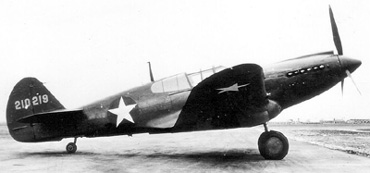 |
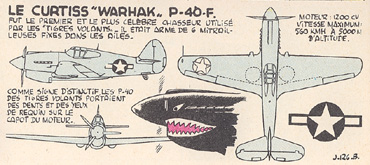 |
In the story LA REVANCHE DES FILS DU CIEL a technical table of the P-40 used by the Flying Tigers is shown. The table wrongly identify this version as a P-40F instead of the P-40E used by the Flying Tiger squadron. Despite the technical table the P-40 Buck Danny and his friends are not show flying the P-40s in this story.
|
The P-40E used by the Flying Tiger are well represented by Francis Bergese in the story LA MASCOTTE. This short but interesting WW II adventure, placed during the period when Buck Danny and friends were on duty with the Flying Tigers squadron, has been published in the TOUT BUCK DANNY n° 15.
|
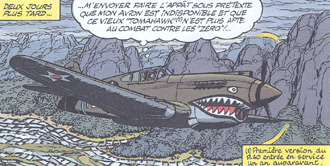 |
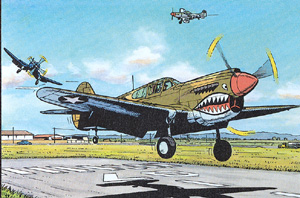 |
A fully restored P-40E Warhawk is well represented in the adventure SABOTAGE AU TEXAS. This aircraft is part of the warbirds collection belong to one of the Sonny's fiancee Lucy "Lulubelle" widow of the rich Texan oilman Hawk.
|
A P-40 seems also represented by Marniquet in the short story L'INEVITABLE RENCONTRE published in 2017 as inedit story on the comic SPIROU #4108 dedicated to the 70th years of the Buck Danny adventures.
|
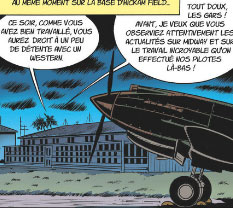 |
 |
The P-40 Warhawk is the first operative aircraft used in 1941 by Sonny Tuckson in the "origins" adventure LETTRES À JO.
|
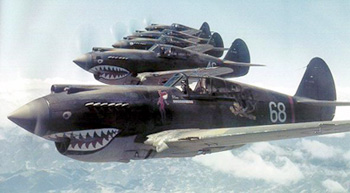 |
The Curtiss P-40 was an American single-engine, single-seat, all-metal fighter and ground attack aircraft. It was used by the air forces of 28 nations, including those of most Allied powers during World War II, and remained in frontline service until the end of the war. By November 1944, when production of the P-40 ceased, 13,738 had been built. The P-40 design was a modification of the previous Curtiss P-36; this reduced development time and enabled a rapid entry into production and operational service.
Warhawk was the name the United States Army Air Corps adopted for all models, making it the official name in the United States for all P-40s. The British Commonwealth and Soviet air forces used the name Tomahawk for models equivalent to the P-40B and P-40C, and the name Kittyhawk for models equivalent to the P-40D and all later variants.
|
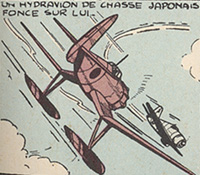 |
In the story LES JAPS ATTAQUENT a not well defined Floatplane fighter is depicted. It could be intended as a Nakajima A6M2-N. The Nakajima A6M2-N Navy Type 2 Floatplane Fighter Model 11 "Rufe" Interceptor/Fighter-Bomber was a single-crew seaplane based on the Mitsubishi A6M Zero Model 11 fuselage, with a modified tail and floats. This floatplane was developed for the purpose of supporting amphibian operations and defending remote bases. |
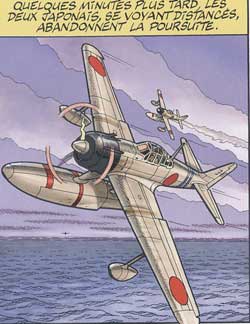 |
Two Nakajima A6M2-N are instead well represented by Bergese in the short adventure LE LACHE published as inedit story on the Les aventures de Buck Danny rècit complet special volume ALERTE NUCLÈAIRE. |
The plane was deployed in 1942, referred to as the "Suisen 2" (Hydro fighter type 2), and was only utilized in defensive actions in the Aleutians and Solomon Islands operations. Such seaplanes were effective at night in harassing American PT boats, and they were very difficult to detect, even with primitive radar. A total of 327 were built, including the original prototype. It was armed with 2x7.7mm Type 97 machine guns with 500 rpg above forward fuselage,
2x20mm Type 99 cannons each with 60-round drum fixed in ounter wings and
wings racks for 2 66lb (30kg) bombs
|
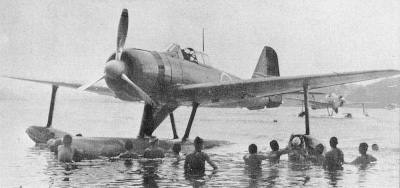 |
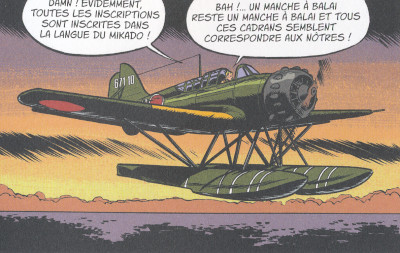 |
In the story BUCK DANNY ORIGINS - LE PILOTE A L'AILE BRISEE Buck Danny was able to stollen from a Japanese submarine a Yokosuka E14Y seaplane. |
The Yokosuka E14Y (Allied reporting name Glen) was an Imperial Japanese Navy reconnaissance seaplane transported aboard and launched from Japanese submarine aircraft carriers such as the I-25 during World War II. The Japanese Navy designation was "Type 0 Small Reconnaissance Seaplane". The E14Y was used for several Japanese reconnaissance missions during the Pacific War.
On 26 February 1942 the Japanese submarine I-25, under the command of Captain Akiji Tagami, was off the northern tip of King Island in Bass Strait off the coast of Victoria, Australia, when an E14Y was launched on a reconnaissance flight over the Port of Melbourne. The pilot and observer/gunner were in the air for three hours, during which time they successfully flew over Port Phillip Bay and observed the ships at anchor off Melbourne before returning to land on its floats beside the submarine, where it was winched aboard and disassembled.
|
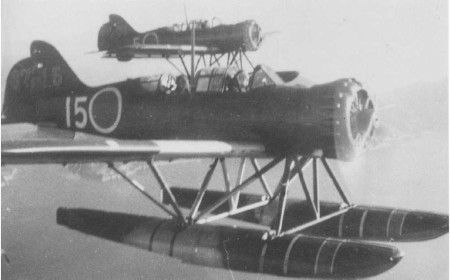 |
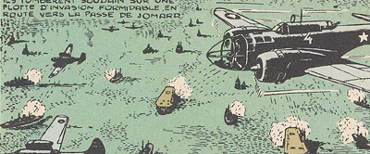 |
In the story LES JAPS ATTAQUENT some images show what seems to be the Martin A-30. Also in this case there is an incongruence because this aircraft was not used in combat by the United States forces, but saw service with the British, Canadian, Australian, South African, Hellenic and the Italian air forces.
|
The Martin 187 Baltimore was a light two-engined attack-bomber built by the Glenn L. Martin Company in the United States. To enable the aircraft to be supplied to the British under the Lend-Lease Act the United States Army Air Forces designation A-30 was allocated. This attack-bomber aircraft was armed with Guns: Four wing mounted 0.303-in(7.7-mm) machine-guns. Two to four 0.303-in(7.7-mm) machine-guns in dorsal turret, two 0.303-in(7.7-mm) machine-guns in ventral position and provisions for up to four fixed rear firing 0.303-in(7.7-mm) machine-guns. Bombs: 2,000 lb (910 kg) carried internally
|
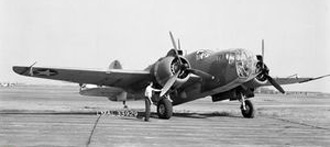 |
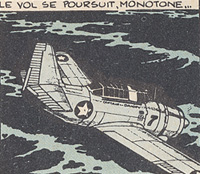 |
In the story LES JAPS ATTAQUENT also a Curtiss SB2C Helldiver was one of the various aircraft used by Buk Danny against the Imperial Japanese Navy. |
A group of Helldivers are also shown during the Midway attack in the story LES MYSTERES DE MIDWAY. The Curtiss SB2C Helldiver was an American aircraft carrier-based dive bomber aircraft produced for the United States Navy during World War II. It replaced the Douglas SBD Dauntless in US Navy service. Despite its size, the SB2C was much faster than the SBD it replaced.
|
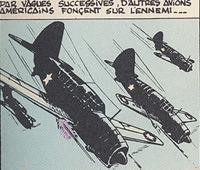 |
In the story LES FANTôMES DU SOLEIL LEVANT a Curtiss SB2C Helldiver is also well represented by Arroyo. |
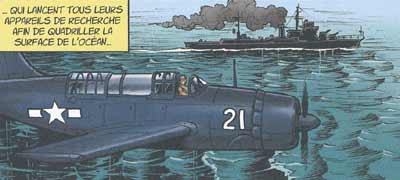 |
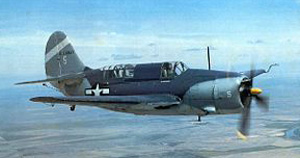 |
Respect to the Dauntless the Helldiver was a much larger aircraft able to operate from the latest aircraft carriers of the time and carry a considerable array of armament and featured an internal bomb bay that reduced drag when carrying heavy ordnance. Saddled with demanding requirements set forth by both the U.S. Marines and United States Army Air Forces, the manufacturer incorporated features of a multi-role aircraft into the design. It was armed with 2 x 20 mm cannon in the wings
2 x 0.30 in (7.62 mm) machine guns in the rear cockpit
Internal bay: 2,000 lb (900 kg) of bombs or 1x Mark 13-2 torpedo
Underwing hardpoints: 500 lb (225 kg) of bombs each.
|
|
Kawasaki Ki-61 Hien "Tony" |
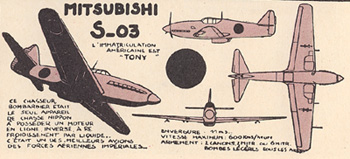 |
In the story LES JAPS ATTAQUENT there is a technical plate where a Japanese fighters is depicted. Based on it general design, the technical characteristics and the code name "Tony" It is probably a Kawasaki Ki-61 Hied even if in the plate the fantasy name of Mitsubishi S-03 is indicated. |
Some Kawasaki Ki-61 Hied are also shown in the story LES MYSTERES DE MIDWAY. This group of fighters attacked the B-17 used by Buck Danny and Susan Holmes to reach Pearl Harbour. During this air battle Susan Holmes get a victory shooting down one of the Ki-61.
|
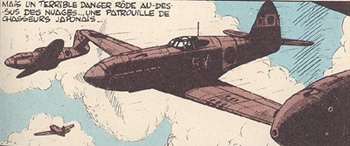 |
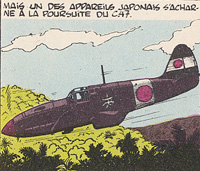 |
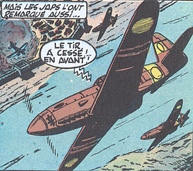 |
The Japanese fighter Kawasaki Ki-61 Hied was also shown in other two stories placed in the Pacific war scene LA REVANCHE DES FILS DU CIEL and TIGRES VOLANTS . |
An image of the Kawasaki Ki-61 Hien is also well represented in the story LE TIGRE DE MALAISIE even this aircraft was not used during the attach conducted by mercenary pilots of the "Malaysia Tigers" organization agaist the US airfield.
|
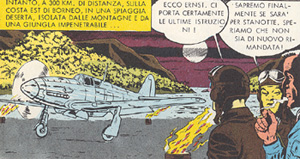 |
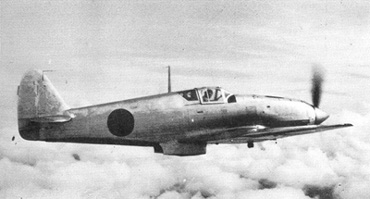 |
The Kawasaki Ki-61 Hien (flying swallow) was a Japanese World War II fighter aircraft used by the Imperial Japanese Army Air Force. The Allied code name assigned by the United States War Department was "Tony". The Japanese Army designation was Army Type 3 Fighter. It was the only mass-produced Japanese fighter of the war to use a liquid-cooled inline "V" engine. It was armed with 2x 20 mm Ho-5 cannon, 120 rounds/gun
2x 12.7 mm (0.50 in) Ho-103 machine guns, 200 rounds/gun and 2x 250 kg (550 lb) bombs
|
|
North American B-25 Mitchell |
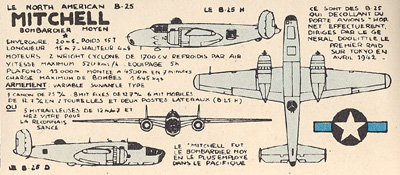 |
In the story LES JAPS ATTAQUENT a technical table is dedicated to the US bomber North American B-25 Mitchell even if in this story the B-25 is not between the aircraft which take part of the fighting. |
A group of North American B-25 Mitchell are instead well represented during a war action in the story LES MYSTERES DE MIDWAY.
|
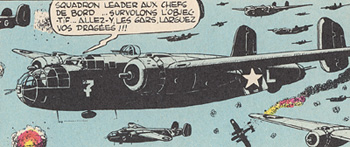 |
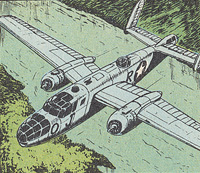 |
In the story LA REVANCHE DES FILS DU CIEL a bombers North American B-25 Mitchell is also used by a group of "Flying tigers" members for a recognise mission over the Japanese controlled area. |
What seems to be a B-25 is partially visible in one drawing of the story PATROUILLE A L'AUBE. The B-25 was located in an old aircraft cemetery of a pacific island with other WW II aircraft like Corsair, Avenger, B-17 and a not well identified Jet of the early 50s.
|
| 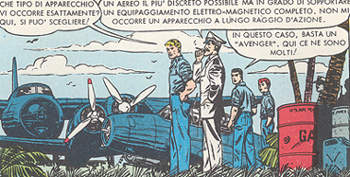 |
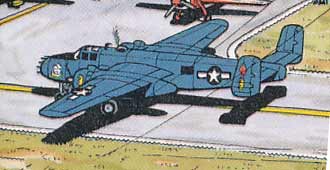 |
In the story SABOTAGE AU TEXAS a restored bombers North American B-25 Mitchell is shown by Bergese. |
A B-25 is also represented during the Korean war on the second story of the new "Spin-off" Buck Danny classical adventure titled DUEL SUR MIG ALLEY
|
| 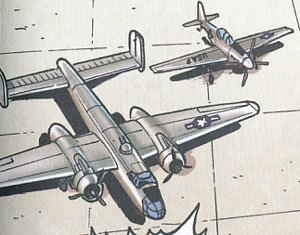 |
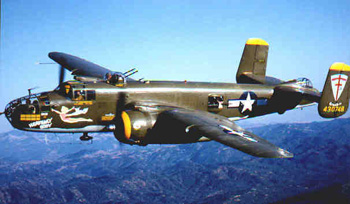 |
The North American B-25 Mitchell (NA-62) was an American twin-engined medium bomber manufactured by North American Aviation. It was used by many Allied air forces, in every theater of World War II, as well as many other air forces after the war ended, and saw service across four decades.
The B-25 was named in honor of General Billy Mitchell, a pioneer of U.S. military aviation. The B-25 is the only American military aircraft named after a specific person. By the end of its production, nearly 10,000 B-25s in numerous models had been built. These included a few limited variations, such as the US Navy's PBJ-1 patrol bomber and the Army Air Forces' F-10 photo reconnaissance aircraft.
|
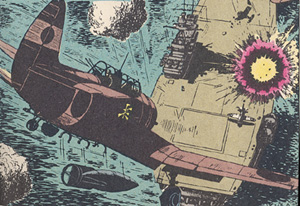 |
A Japanese dive bomber Aichi D3A "Val" seem to be represented in the story LES JAPS ATTAQUENT Buck Danny. This dive bomber is depicted during the Japanes attach against the US Navy Aircraft carrier USS Yorktown |
A couple of Aichi D3A "Val" are better represented during the take off from a Japanese aircraft carrier during the Midway battle in the story LES MYSTERES DE MIDWAY.
|
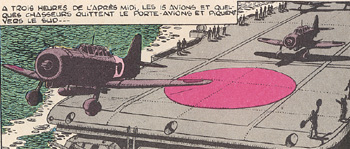 |
Some Aichi D3A "Val" are also represented in the story BUCK DANNY ORIGINS - LE PILOTE A L'AILE BRISEE.
|
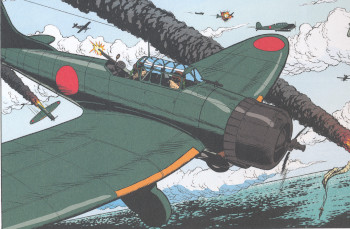 |
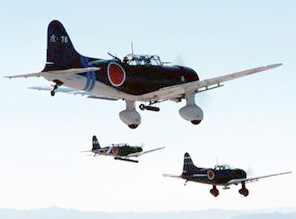 |
The Aichi D3A (Allied code name Val) was a World War II dive bomber produced by the Aichi company in Japan. It was the primary carrier-borne dive bomber in the Imperial Japanese Navy in the early stages of the war, and participated in almost all actions, including Pearl Harbor. It was armed with 2 fixed forward 7.7 mm (0.303 in) Type 97 machine guns, 1 aimed rear 7.7 mm (0.303 in) Type 92 machine gun and 1 × 250 kg (550 lb) or 2 × 60 kg (130 lb) bombs
. |
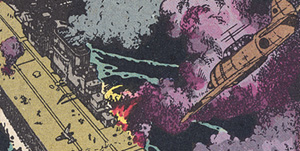 |
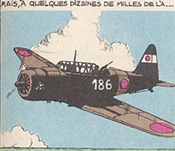 |
In the story LES JAPS ATTAQUENT a Japanese torpedo bomber Nakajima B5N is depicted attacking an US Navy aircraft carrier.
A similar aircraft is more likely depicted in the story LA REVANCHE DES FILS DU CIEL |
The Nakajima B5N (Allied reporting name Kate) was the Imperial Japanese Navy's standard torpedo bomber for the first years of World War II. While the B5N was substantially faster and more capable than its Allied counterparts, the TBD Devastator and Fairey Swordfish, it was close to obsolescence by the time of the Pearl Harbor Attack. Nevertheless, the B5N operated throughout the whole war. Although primarily used as a carrier-based aircraft, it was also used as a land-based bomber on occasions. The B5N had a crew of 3: pilot, navigator/bombardier/observer, and radio operator/gunner.
|
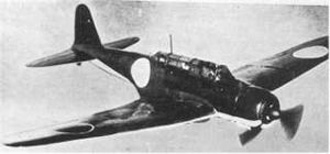 |
|
Mitsubishi KI-15 "Karigane; |
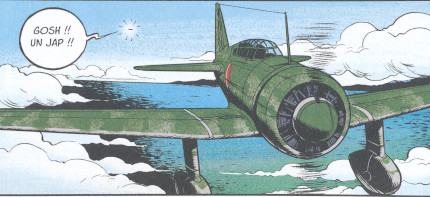 |
In the "origins" story LETTRES À JO a Japanese reconnaissance aircraft and a light attack bomber Mitsubishi KI-15 is represented by De Luca. |
The Mitsubishi Ki-15 "Karigane" (Wild goose), Army Type 97 Command Reconnaissance aircraft was a Japanese reconnaissance aircraft and a light attack bomber of the Second Sino-Japanese War and Pacific War. It began as a fast civilian mail-plane. It was a single-engine, low-wing, cantilever monoplane with a fixed tailwheel undercarriage; it carried a crew of two. It served with both the Imperial Japanese Army and Navy (as the C5M). During World War II it was code-named "Babs" by the Allies.
|
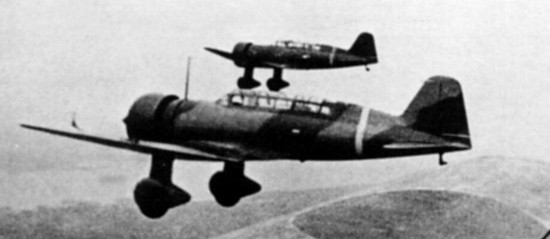 |
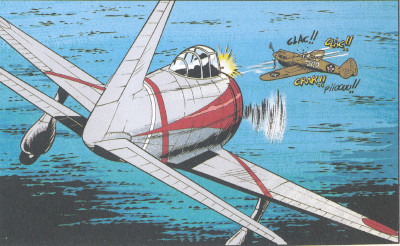 |
In the "origins" story LETTRES À JO a Japanese fighter Nakajima Ki-27 is represented by De Luca. |
The Nakajima Ki-27 (Type 97 Fighter) was the main fighter aircraft used by the Imperial Japanese Army Air Service up until 1940. Its Allied nickname was "Nate", although it was called "Abdul" in the "China Burma India" (CBI) theater by many post-war sources; Allied Intelligence had reserved that name for the nonexistent Mitsubishi Navy Type 97 fighter, expected to be the successor to the carrier-borne Type 96 (Mitsubishi A5M) with retractable landing gear and an enclosed cockpit.
|
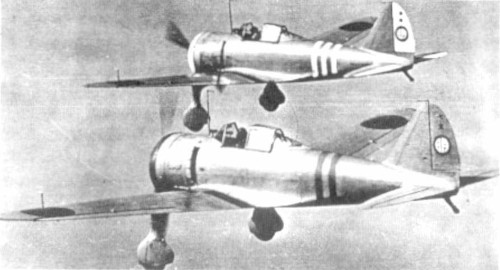 |
|
Mitsubishi A6M Zero-sen "Zeke" , "Hamp", "Hap" |
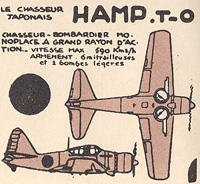 |
In the story LES JAPS ATTAQUENT a small technical table shows the Japanese fighter aircraft Mitsubishi A6M Zero-sen probably one of the most famous Imperail Japanese Navy Fighter of the WW II. |
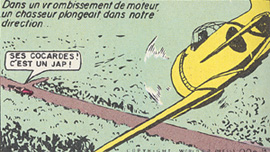 |
Always in the story LES JAPS ATTAQUENT a single image shows what seems to be a very approssimative representation of a Mitsubishi A6M Zero-sen.
|
Some Mitsubishi A6M Zero-sen are also shown in two adventures realted with the " Flying Tigers" LA REVANCHE DES FILS DU CIEL and LES TIGRES VOLANTS. |
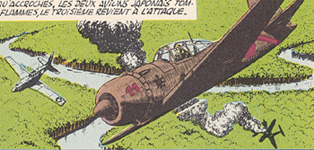 |
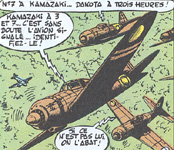 |
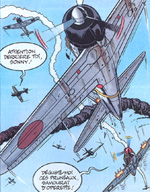 |
A very beautiful images of a dog fight between the "Flying Tigers" P-40s and some Japanese Zeros is depicted by Bergese is his story LA MASCOTTE published in the TOUT BUCK DANNY n° 15. |
A group of destroyed Japanese Zero are well represented by Arroyo in the story LES FANTôMES DU SOLEIL LEVANT . |
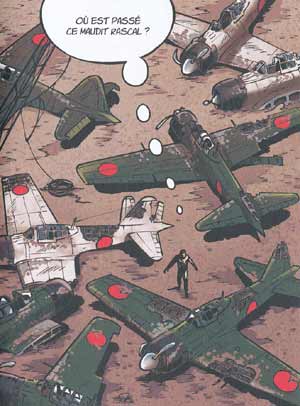 |
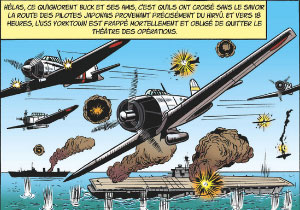 |
A group of Japanese Zero are also represented by Marniquet in the short story L'INEVITABLE RENCONTRE published in 2017 as inedit story on the comic SPIROU #4108 dedicated to the 70th years of the Buck Danny adventures. |
The Japanese Zero are represented by De Luca in the adventures BUCK DANNY ORIGINS - LE PILOTE A L'AILE BRISEE and LE FILS DU VIKING NOIR . |
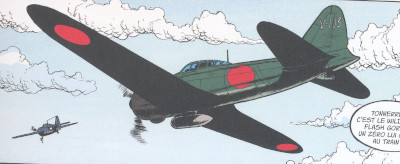 |
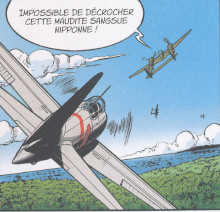 |
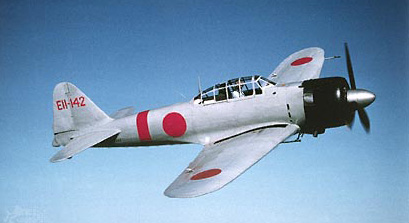 |
The Mitsubishi A6M Zero-sen was a lightweight fighter aircraft operated by the Imperial Japanese Navy Air Service (IJNAS) from 1940 to 1945. The origin of its official designation was that "A" signified a fighter and "6" for the sixth model built by Mitsubishi ("M"). The A6M was usually referred to by the Allies as the "Zero" a name that was frequently misapplied to other Japanese fighters, such as the Nakajima Ki-43 as well as other codenames and nicknames, including "Zeke", "Hamp" and "Hap". It was armed with 2× 7.7 mm (0.303 in) Type 97 machine guns in the engine cowling 2× 20 mm (0.787 in) Type 99 cannons in the wings and 2× 60 kg (132 lb) bombs or 2× fixed 250 kg bombs for kamikaze attacks.
|
 |
In the story LES MYSTERES DE MIDWAY a technical table shows the US Navy carrier-based fighter Grumman F4F Wildcat even if the aircraft used by Buck Danny at the beginning of this story is more likely a Grumman F6F-3 Hellcat. |
Some F4F Wildcat are instead well represented by Bergese in the short adventure LE LACHE published as inedit story on the Les aventures de Buck Danny rècit complet special volume ALERTE NUCLÈAIRE. |
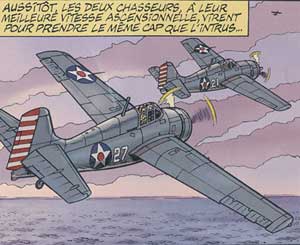 |
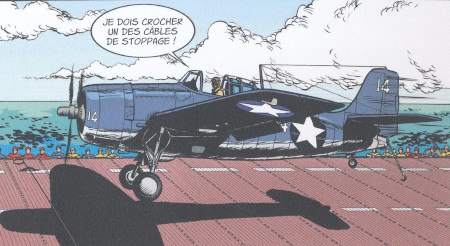 |
Buck Danny is flying the Grumman F4F Wildcat from USS Enterprise in the story BUCK DANNY ORIGINS - LE PILOTE A L'AILE BRISEE and LE FILS DU VIKING NOIR. |
The Grumman F4F Wildcat was an American carrier-based fighter that began service with both the United States Navy and the Fleet Air Arm in 1940. Although first used in combat by the British in Europe, the Wildcat would become the primary carrier fighter for the first year and a half of the United States Navy's involvement in World War II in the Pacific Theater. The FM Wildcat, an improved version built by General Motors, remained in service throughout the remainder of the war on escort carriers, where larger and heavier fighters could not be used.
|
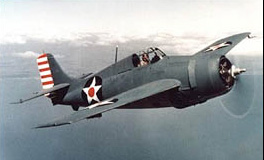 |
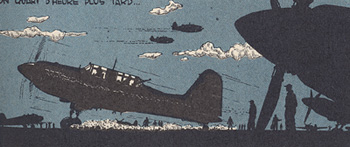 |
In the story LES MYSTERES DE MIDWAY a not well defined Japanese light bomber is depicted. It is more likely a Kawasaki Ki-32 even if in the other images it was wrongly drawn with the undercarriage retracted. |
The Kawasaki Ki-32 was a Japanese light bomber aircraft of World War II. It was a single-engine, two-seat, mid-wing, cantilever monoplane with a fixed tailwheel undercarriage. An internal bomb bay accommodated a 300 kg offensive load, supplemented by 150 kg of bombs on external racks. During the war, it was known by the Allies by the code-name "Mary".
|
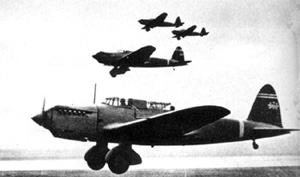 |
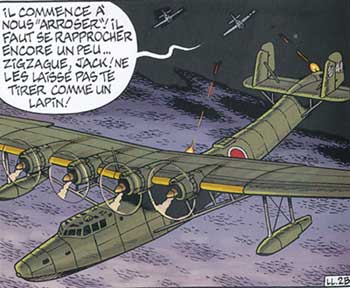 |
A Japanese flying boat Kawanishi H6K "Mavis" is well represented by Bergese in the short adventure LE LACHE published as inedit story on the Les aventures de Buck Danny rècit complet special volume ALERTE NUCLÈAIRE |
The Kawanishi H6K was an Imperial Japanese Navy flying boat produced by the Kawanishi Aircraft Company and used during World War II for maritime patrol duties. The Allied reporting name for the type was Mavis; the Navy designation was Type 97 Large Flying Boat.
The aircraft was designed in response to a Navy requirement of 1934 for a long range flying boat and incorporated knowledge gleaned by a Kawanishi team that had visited the Short Brothers factory in the UK, at that time one of the world's leading producers of flying boats, and from building the Kawanishi H3K, a license-built, enlarged version of the Short Rangoon. The Type S, as Kawanishi called it, was a large, four-engine monoplane with twin tails, and a hull suspended beneath the parasol wing by a network of struts. Three prototypes were constructed, each one making gradual refinements to the machine's handling both in the water and in the air, and finally fitting more powerful engines. The first of these flew on 14 July 1936 and was originally designated Navy Type 97 Flying Boat, later H6K. Eventually, 217 would be built.
|
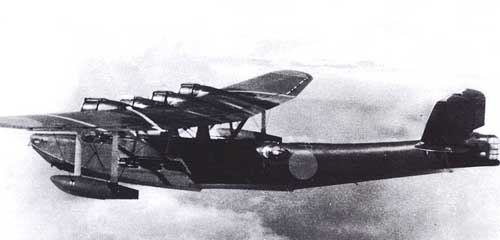 |
|
Boeing B-17 Flying Fortress |
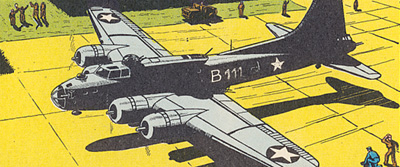 |
In the story LES MYSTERES DE MIDWAY Buck Danny and Susan Holmes flow on a B-17. During this flight Susan was also able to shoot down a Japanese fighter. Despite the damage suffered by the Flying Fortress during the Jappanese fighters attack Buck Danny made a perfect emergency landing at Pearl Harbour and Susan Holmes get her victory score painted in the US bomber's fuselage. |
In the story LA REVANCHE DES FILS DU CIEL Buck Danny and Sonny Tuckson are flying as passengers on a B-17. In the reality should have been more likely used the modified transportation variant of the B-17 designated C-108.
|
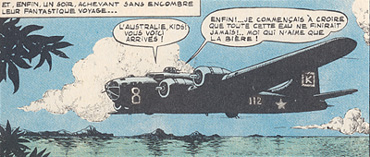 |
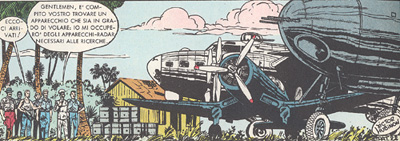 |
A B-17 is partially visible in one drawing of the story PATROUILLE A L'AUBE. The B-17 was located in an old aircraft cemetery of a pacific island with other WW II aircraft like Corsair, Avenger, B-25 and a not well identified Jet of the early 50s.
|
The Boeing B-17 Flying Fortress is a four-engine heavy bomber aircraft developed for the United States Army Air Corps (USAAC). The B-17 was primarily employed in the daylight precision strategic bombing campaign of World War II against German industrial, civilian and military targets. The B-17 also participated, to a lesser extent, in the War in the Pacific, where it conducted raids against Japanese shipping.It was armed with Guns: 13× M2 Browning .50 caliber (12.7 mm) machine guns in twin turrets, plus single dorsal, fore and aft beam positions (with optional extra nose armament fitted in glazed nose).
Bombs: Although it theoretically could carry 17,417 lb (7900 kg) of bombs in F version blocks with wing racks or 12,800 lb (5,800 kg) in the G model with just the fuselage bomb bay, the B-17 rarely flew combat missions with more than 5,071 lb (2300 kg).
|
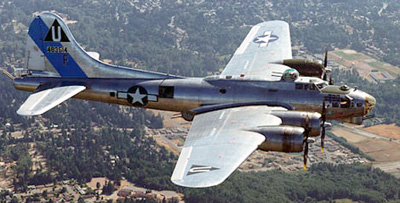 |
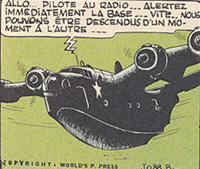 |
In the story LES MYSTERES DE MIDWAY a large US Navy Flying Boat is depicted. Its general design shows some similarity with the Martin PBM Mariner even if it has been wrongly represented with four engines and with the fantasy designation of PB5Y |
In the story GHOST QUEEN a misterious flying boat is depicted. Its exact designation is not specified but the general design is very similar to the Martin PBM Mariner even if the crew seems to be composed by Japanese mercenary pilots.
|
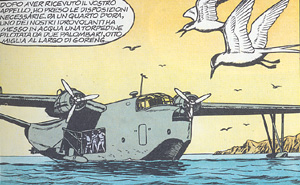 |
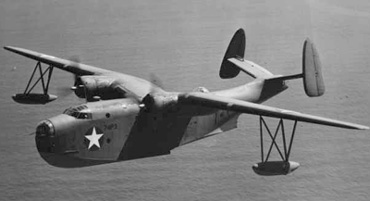 |
The Martin PBM Mariner was a patrol bomber flying boat of World War II and the early Cold War period. It was designed to complement the PBY Catalina in service. 1,366 were built, with the first example flying on February 18 1939 and the type entering service in September 1940.The aircraft was fitted with five gun turrets and bomb bays that were in the engine nacelles. The gull wing was of cantilever design, and featured clean aerodynamics with an unbraced twin tail. The PBM-1 was equipped with retractable wing landing floats that were hinged inboard, while the PBM-3 had fixed floats. Also the fuselage of the PBM-3 was three feet longer than the PBM-1.
|
|
Consolidated PBY Catalina |
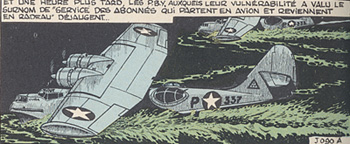 |
In the story LES MYSTERES DE MIDWAY a group of Consolidated PBY Catalina are shown during a patrol bomber mission. They attacked and destroyed by mans of torpedoes some Japanese cargo ships. |
A partially sinked and destroyed Consolidated PBY Catalina is also shown in the story PATROUILLE A L'AUBE, where a criminal organisation lead by a former Nazi U-Boat commander abduct the three US Navy pilots and obligate them to find a WW II Nazi treasure lost in a sinked German submarine.
|
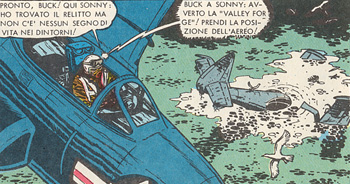 |
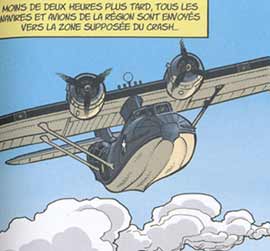 |
A Consolidated PBY Catalina is also shown by Arroyo in the stories LES FANTôMES DU SOLEIL LEVANT and L'ILE DU DIABLE. |
A Consolidated PBY Catalina is also shown by De Lucain the story BUCK DANNY ORIGINES - LE FILS DU VIKING NOIR.
|
 |
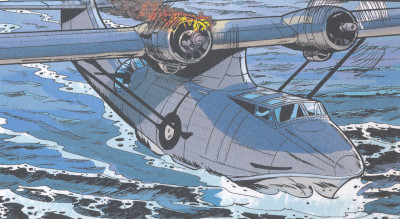 |
A Consolidated PBY Catalina is also shown by Le Bras in the story MOLOTOK-41 NE REPOND PLUS. |
The PBY Catalina was an American flying boat of the 1930s and 1940s produced by Consolidated Aircraft. It could be equipped with depth charges, bombs, torpedoes, and .50 Browning machineguns and was one of the most widely used multi-role aircraft of World War II. PBYs served with every branch of the US military and in the air forces and navies of many other nations. In World War II, PBYs were used as anti-submarine warfare aircraft, patrol bombers, convoy escorts, search and rescue aircraft, and transports. The PBY was the most successful aircraft of its kind, as no other flying boat was produced in greater numbers.
| 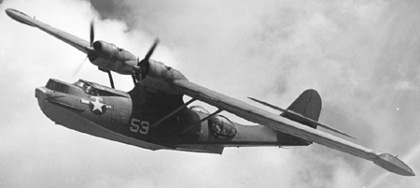 |
 |
In the story LES MYSTERES DE MIDWAY a group of Martin B26 Marauder are shown during a bomber mission against the Japanese aircraft carrier Agaki. |
In the stories ALERTE ATOMIQUE and L'ESCADRILLE DE LA MORT some Martin B26 Marauder are also used by a group of mercenary pilots recruited in the militia of the General Diaz. This Manteguan dictator planed to use the B-26 for a nuclear attack agaist the headquarter of his enemy Cutierrez.
|
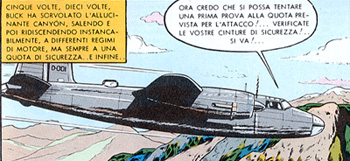 |
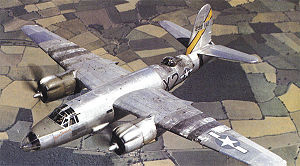 |
The Martin B-26 Marauder was a World War II twin-engine medium bomber built by the Glenn L. Martin Company.
The first medium bomber in the Pacific Theater in early 1942, it was also used in the Mediterranean Theater and North West Europe. The plane distinguished itself as "the chief bombardment weapon on the Western Front" according to an U.S. Army Air Forces dispatch from 1946, and later variants maintained the lowest loss record of any combat aircraft during World War II.It was armed with Guns: 12× .50 in (12.7 mm) Colt-Browning machine guns
and Bombs: 4,000 lb (1,800 kg)
|
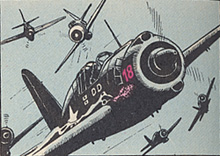 |
In the story LES MYSTERES DE MIDWAY some US Marines Corp F2A Buffalo are shown during the air combats against the Japanese fighters attacking the Midway island. |
The Brewster F2A (company Model 139) was an American fighter aircraft which saw limited service during World War II. In 1939, the F2A became the first monoplane fighter aircraft used by the US Navy.It also saw action with US Marine Corps squadrons at the Battle of Midway. It was armed with 2 x 0.50 cal (12.7 mm) nose-mounted machine guns 2 x 0.50 cal (12.7 mm) wing-mounted machine guns
two 100-pound (45.36 kg) underwing bombs.
|
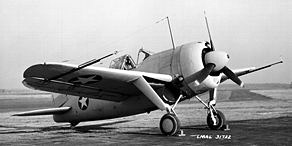 |
|
Douglas C-47 Skytrain / C-53 Skytrooper / DC-3 / R4D-5L / R4D-1 |
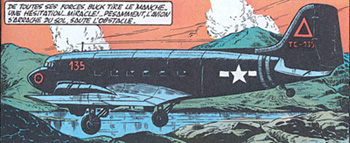 |
The military transport aircraft Douglas C-47 Skytrain is well depicted and largely used in the stories LA REVANCHE DES FILS DU CIEL and LES TIGRES VOLANTS |
The specialized paratroop variant of the C-47 designated C-53 Skytrooper is present in the story ATTAQUE EN BIRMANIE
|
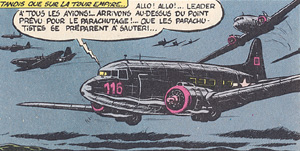 |
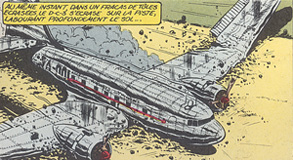 |
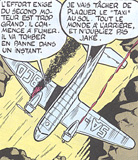 |
In the stories LES TRAFIQUANTS DE LA MER ROUGE, LES PIRATES DU DESERT and LES GANGSTERS DU PETROLE Buck Danny and his comrades flow with the civilian variant of the C-47 designated DC-3 for the "fake" company Arabian Airways. |
Another variant of the C-47 was the US Navy version designated R4D-1. In the story NC 22654 NE REPOND PLUS the R4D-5 variant for use in Antarctica is shown. This special version was designated R4D-5L.
|
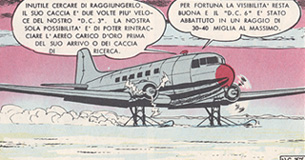 |
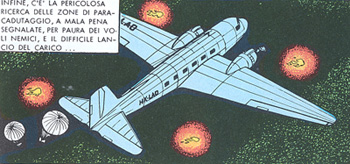 |
A DC-3 or its military variant C-47 is also shown in the story ALERTE ATOMIQUE. It was used for some illegal trafics in the fantasy Central American state of Mantegua. |
A C-47 is also shown by Arroyo in the stories LES FANTôMES DU SOLEIL LEVANT and L'ILE DU DIABLE. |
 |
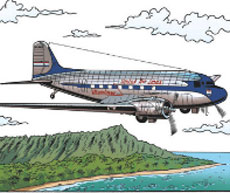 |
A civilian DC-3 is also represented by Marniquet in the short story L'INEVITABLE RENCONTRE published in 2017 as inedit story on the comic SPIROU #4108 dedicated to the 70th years of the Buck Danny adventures. |
Another US Navy version R4D-1 is also shown by in the Classic #7 story SEA DART. |
 |
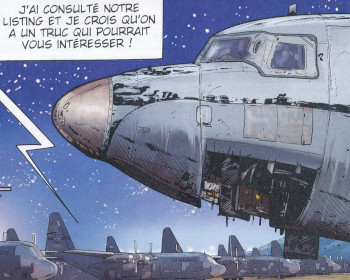 |
A decommissioned C-47 is also show by Formosa in the story LE PACTE! |
A couple of C-47 are also shown by in the Classic #8 story LE REPAIR DE L'AIGLE. |
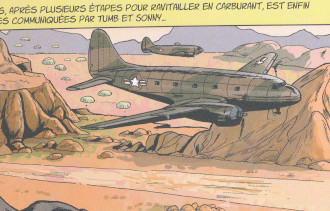 |
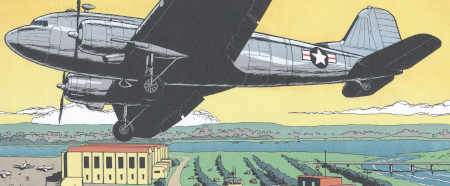 |
A C-47 is well represented by De Luca in the story BUCK DANNY ORIGINES - LE PILOTE A L'AILE BRISEE |
Some DC-3 of Amrican Airlines are also shown in the New York airport La Guardia in the adventure BUCK DANNY ORIGINES - LE PILOTE A L'AILE BRISEE. |
 |
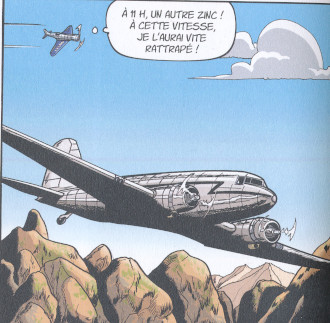 |
A DC-3 is well depiced by Le Bras in the story Buck Danny classic#11 L'OMBRE ROUGE |
The Douglas C-47 Skytrain or Dakota is a military transport that was developed from the Douglas DC-3 airliner. It was used extensively by the Allies during World War II and remained in front line operations through the 1950s with a few remaining in operation to this day. In Europe, the C-47 and a specialized paratroop variant, the C-53 Skytrooper, were used in vast numbers in the later stages of the war, particularly to tow gliders and drop paratroops. In the Pacific, with careful use of the island landing strips of the Pacific Ocean, C-47s were even used for ferrying soldiers serving in the Pacific theater back to the United States.
| 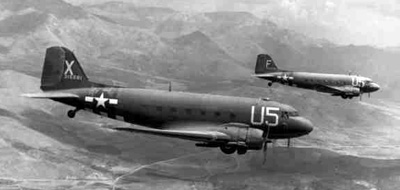 |
|
Consolidated B-24 Liberator |
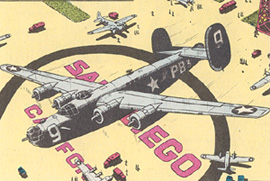 |
In the story LA REVANCHE DES FILS DU CIEL Buck Danny meet for the first time Sonny Tuckson during a transfer flight on board of a B-24. In the reality for the transport activity a modified variant of the B-24 designate C-87 Liberator Express was used |
The Consolidated B-24 Liberator was an American heavy bomber, built by Consolidated Aircraft. It was produced in greater numbers than any other American combat aircraft of World War II and still holds the record as the most produced U.S. military aircraft. It was used by many Allied air forces and every U.S. branch of service during the war, attaining a distinguished war record with its operations in the northern European, Pacific and Mediterranean theaters. It was armed with; Guns: 10× .50 in (12.7 mm) M2 Browning machine guns
Bombs:Short range (˜400 mi): 8,000 lb (3,600 kg)
Long range (˜800 mi): 5,000 lb (2,300 kg)
Very long range (˜1,200 mi): 2,700 lb (1,200 kg)
|
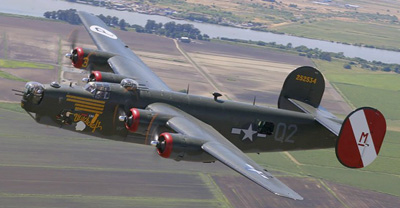 |
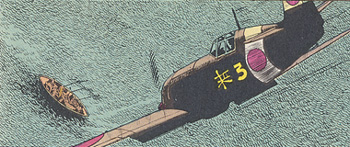 |
In the story LA REVANCHE DES FILS DU CIEL The lifeboat with Buck Danny and other US Army aviation pilots is attacked by a Japanese fighter Kawasaki Ki-100. |
The Kawasaki Ki-100 was a fighter aircraft used by the Imperial Japanese Army in World War II. The Japanese Army designation was "Type 5 Fighter". Missions began in March 1945; from the first engagements the Ki-100 showed its good qualities against the USAAF B-29 heavy bombers at high altitudes, and showed itself equally effective against U.S. Navy carrier fighters. It was armed with 2 × 20 mm wing-mounted Ho-5 cannons, 250 20x94 mm rounds/gun
2 × 12.7 mm fuselage-mounted Ho-103 machine guns, 250 12.7x81 mm rounds/gun
|
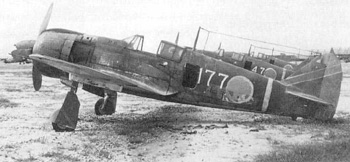 |
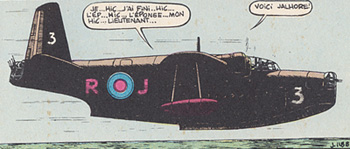 |
In the story LA REVANCHE DES FILS DU CIEL Buck Danny and other US Army aviation pilots are rescued by a British flying boat patrol bomber Short S.25 Sunderland. |
A Short S.25 Sunderland is also used by the international criminal organization which tried to steal the Mercury capsule in the story LES VOLEURS DE SATELLITE. |
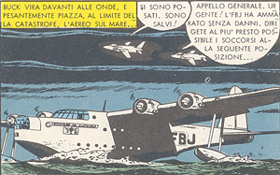 |
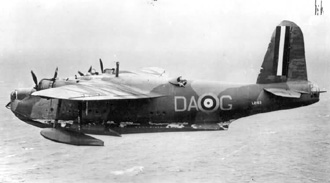 |
The Short S.25 Sunderland was a British flying boat patrol bomber developed for the Royal Air Force by Short Brothers, first flown on 16 October 1937. Based in part upon the S.23 Empire flying boat, the flagship of Imperial Airways, the S.25 was extensively re-engineered for military service. It was one of the most powerful and widely used flying boats throughout the Second World War,and was involved in countering the threat posed by German U-boats in the Battle of the Atlantic. It took its name from the town of Sunderland in northeast England.
|
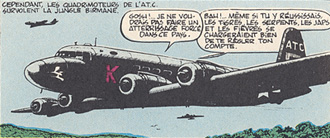 |
In the story LA REVANCHE DES FILS DU CIEL a Douglas C-54 Skymaster four-engined transport aircraft used by the United States Army Air Forces is well depicted. |
This largely used transport aircraft is also shown in a couple of representations in the stories TIGRES VOLANTS and ATTAQUE EN BIRMANIE.
|
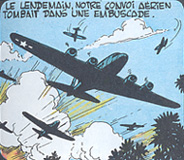 |
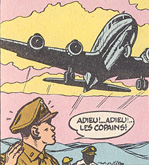 |
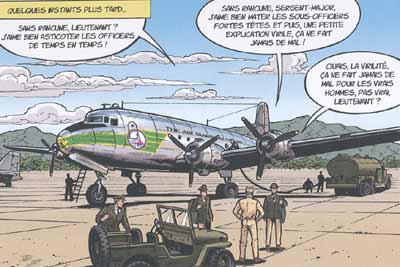 |
A C-54 is also shown by Arroyo in the story LES FANTôMES DU SOLEIL LEVANT. |
A C-54 is also shown in the Buck Danny Classic #8 LE REPAIR DE L'AIGLE.
|
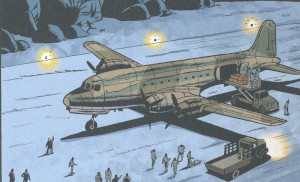 |
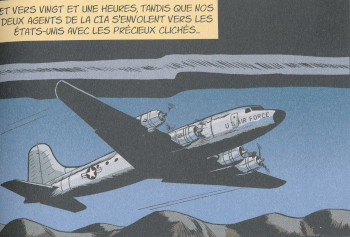 |
A C-54 is also shown in the story LE VOL DU RAPIER. |
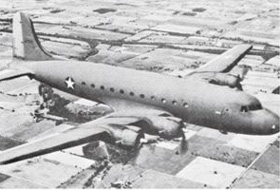 |
The Douglas C-54 Skymaster was a four-engined transport aircraft used by the United States Army Air Forces in World War II. C-54s began service with the Army Air Forces in 1942, carrying up to 26 passengers. (Later versions carried up to 50 passengers.) The U.S. Navy also acquired the type, under the designation R5D. The C-54 was one of the most commonly used long-range transports by the U.S. armed forces in World War II.
|
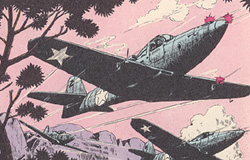 |
In the story LA REVANCHE DES FILS DU CIEL some fighter aircraft Bell P-39 Airacobra are shown during a fighting against a group of japanese bombers. |
In the story L'ILE DU DIABLE some fighter aircraft Bell P-39 Airacobra are shown by Arroyo. |
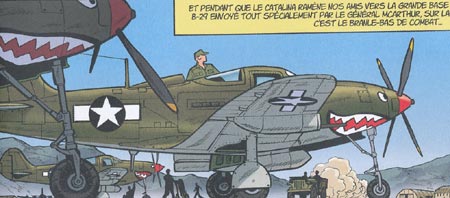 |
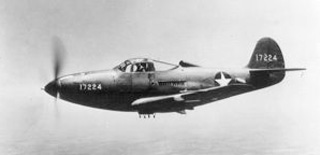 |
The Bell P-39 Airacobra was one of the principal American fighter aircraft in service at the start of World War II. Although its mid-engine placement was innovative, the P-39 design was handicapped by the lack of an efficient turbo-supercharger, limiting it to low-altitude work. It was armed with 1x 37 mm M4 cannon firing through the propeller hub at the rate of 140 rpm with 30 rounds of HE ammo. 4 x .50 cal (12.7 mm) machine guns. Rate of fire was 750 rpm x 1 gun in each wing, only 300 rpm each x 2 guns synchronized in the cowl. Ammo: 200 rounds per nose-gun, 300 per wing-pod. Up to 500 lb (230 kg) of bombs externally
|
|
North American P-51 Mustang |
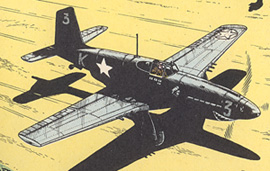 |
In the story LA REVANCHE DES FILS DU CIEL Some North American P-51A Mustang are also used by the pilots of the "Flying Tiger". In the reality the P-40E Warhawk was the only fighter on duty with the "Flying Tigers" group. |
Others P-51A Mustang are shown in the stories LES TIGRES VOLANTS and ATTAQUE EN BIRMANIE.
|
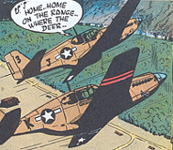 |
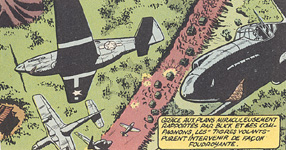 |
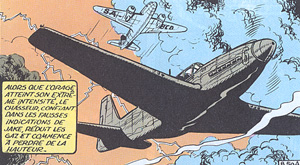 |
In the story LES PIRATE DU DESERT the British variant of the P-51A designated Mk I is more likely represented. |
In the story LES GANGSTERS DU PETROLE some Mustang in the version of P-51B or P-51C are used by Buck Danny and his comrades.
|
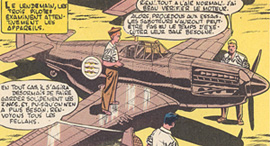 |
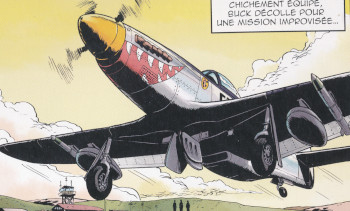 |
Buck Danny and friends are flying the F-51D version of the Mustang P-51D of 12th Fighter Bomber Squadron in Korea in 1952. |
Some P-51 Mustang are also represented during the Korean war on the second story of the new "Spin-off" Buck Danny classical adventure titled DUEL SUR MIG ALLEY
|
| 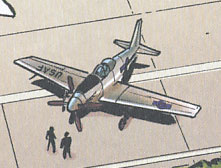 |
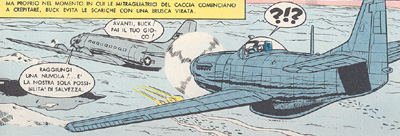 |
A P-51D is used by a criminal organisation to shoot down some transport aircraft flying over the North Pole in order to steal the worthy load. |
In the story BUCK DANNY CONTRE LADY X the first aircraft used by LADY X is more likely the British variant of the P-51 designated Mk III having the characteristic fishbowl-shaped sliding canopy. the British had field-modified some Mustangs with this type of canopy called "Malcolm Hoods". Eventually all Mk IIIs, along with some American P-51B/Cs, were equipped with Malcolm Hoods.
|
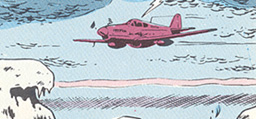 |
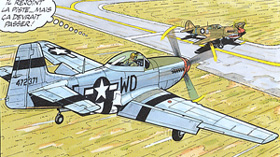 |
In the adventure SABOTAGE AU TEXAS Buck Danny during an Air-show is flying with a fully restored P-51D Mustang. This aircraft is part of the warbirds collection belong to one of the Sonny's fiancee Lucy "Lulubelle" widow of the rich Texan oilman Hawk. |
In the story L'ILE DU DIABLE some fighter aircraft P-51 Mustang are well represented by Arroyo. |
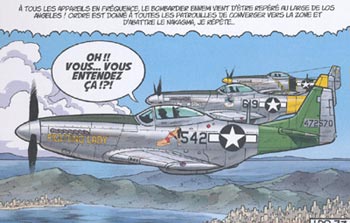 |
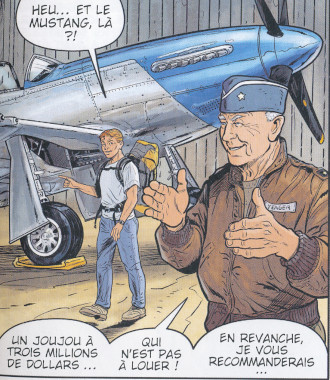 |
In the story PROGRAMME SKYBORG a P-51 Mustang it is one of the private aircraft of the General Chuck Yeager. |
In the "classic" story ATOMIC CITY some fighter aircraft P-51 Mustang are well represented by LeBras. |
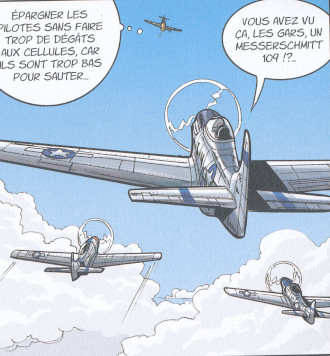 |
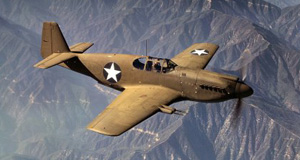 |
The North American Aviation P-51 Mustang was an American long-range single-seat fighter aircraft that entered service with Allied air forces in the middle years of World War II.
The P-51 flew most of its wartime missions as a bomber escort in raids over Germany, helping ensure Allied air superiority from early 1944. It also saw limited service against the Japanese in the Pacific War.
|
The Mustang began the Korean War as the United Nations' main fighter, but was relegated to a ground attack role when superseded by jet fighters early in the conflict. Nevertheless, it remained in service with some air forces until the early 1980s. The P-51D was armed with 6 × 0.50 in (12.7 mm) machine guns; 400 rounds per gun for the two inboard guns; 270 per outboard gun
2 hardpoints for up to 2,000 lb (907 kg)
10 × 5 in (127 mm) rockets. |
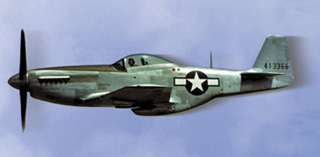 |
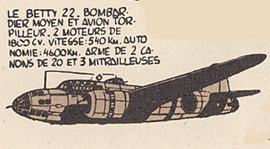 |
In the story LA REVANCHE DES FILS DU CIEL a technical table shows the twin-engined Japanese bomber Mitsubishi G4M "Betty". |
A Japanese bomber Mitsubishi G4M "Betty" is also whown by Arroyo in the story LES FANTôMES DU SOLEIL LEVANT. |
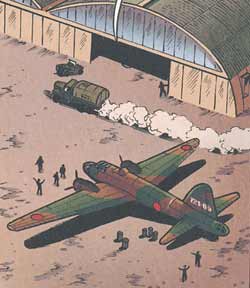 |
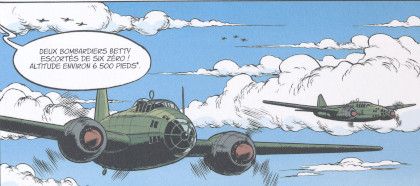 |
In the story BUCK DANNY ORIGINES - LE FILS DU VIKING NOIR some Japanese bomber Mitsubishi G4M "Betty" are well depicted by De Luca. |
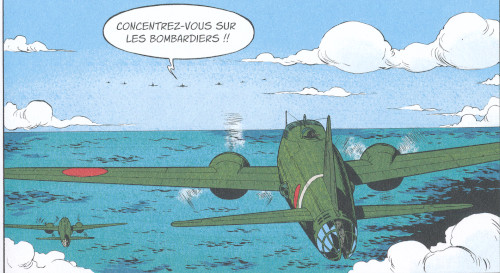 |
In the story BUCK DANNY ORIGINES - LETTRES À JO some Japanese bomber Mitsubishi G4M "Betty" are also well depicted by De Luca. |
The Mitsubishi G4M Type 1 land-based attack aircraft, with the Allied identification name of Betty was a twin-engined, land-based bomber aircraft used by the Imperial Japanese Navy in World War II. It was armed with Guns: 2 × 20mm Type 99 cannon, 4 × 7.7 mm Type 92 machine guns
Bombs: Up to 1,000 kg (2,200 lb) of bombs or single Type 91 torpedo. The heaviest single bomb it can hold is 800 kg.
|
 |
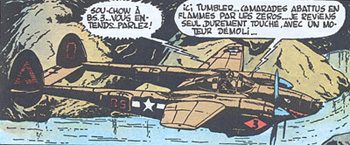 |
In the story TIGRES VOLANTS the Lockheed P-38 Lightning is shown in the color of the "Flying Tiger". In the reality, even if this fighter was actually used in the China-Burma-India Theater of Operations, it was not on duty with the "Flying Tigers" group. |
In the story LES FANTôMES DU SOLEIL LEVANT Sonny Tuckson is also flying a Lockheed P-38 Lightning. |
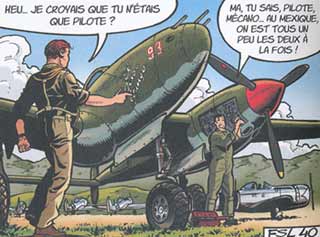 |
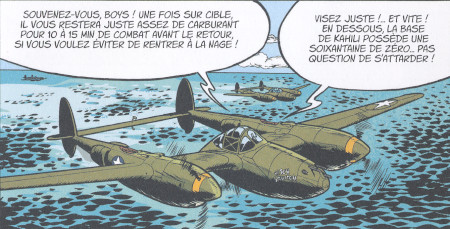 |
Some Lockheed P-38 Lightning are also show by De Luca in the story BUCK DANNY ORIGINES - LE FILS DU VIKING NOIR |
The Lockheed P-38 Lightning was a World War II American fighter aircraft. Developed to a United States Army Air Corps requirement, the P-38 had distinctive twin booms and a single, central nacelle containing the cockpit and armament. The aircraft was used in a number of different roles, including dive bombing, level bombing, ground strafing, photo reconnaissance missions, and extensively as a long-range escort fighter when equipped with droppable fuel tanks under its wings. The P-38 was used most extensively and successfully in the Pacific Theater of Operations and the China-Burma-India Theater of Operations, where it was flown by the American pilots with the highest number of aerial victories to this date.
| 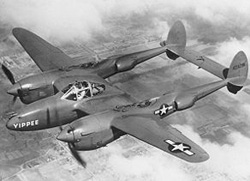 |
|
Bristol Type 156 Beaufighter |
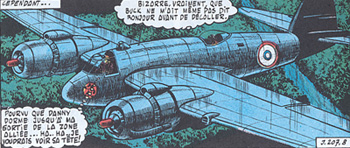 |
In the story TIGRES VOLANTS the Japanese spy Mo-choung-young and Susan Holmes flow on board of a British long range heavy fighter Bristol Type 156 Beaufighter |
The Bristol Type 156 Beaufighter, often referred to as simply the Beau, was a British long-range heavy fighter modification of the Bristol Aeroplane Company's earlier Beaufort torpedo bomber design. The name Beaufighter is a portmanteau of "Beaufort" and "fighter".
Unlike the Beaufort, the Beaufighter had a long career and served in almost all theatres of war in the Second World War, first as a night fighter, then as a fighter bomber and eventually replacing the Beaufort as a torpedo bomber.
|
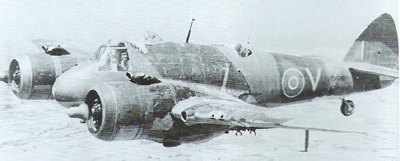 |
|
Republic P-47 Thunderbolt |
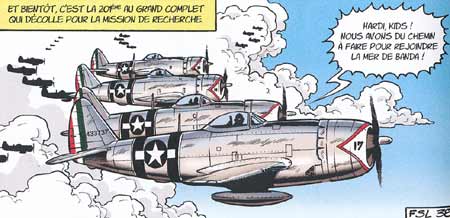 |
The P-47 Thunderbolt's of the Mexican 201st fighter squadron based in the Philippines are shown in the stories LES FANTôMES DU SOLEIL LEVANT and L'ILE DU DIABLE |
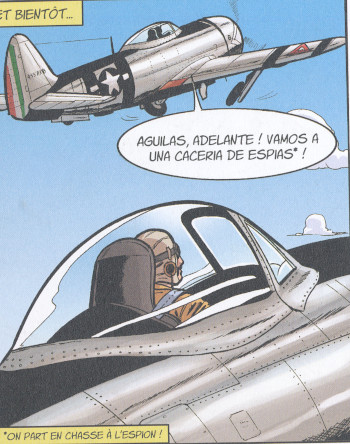 |
Other P-47 Thunderbolt's of the Mexican Air Force are also shown in the "classic" adventure ATOMIC CITY |
The Republic P-47 Thunderbolt is one of the largest and heaviest fighter aircraft in history to be powered by a single 4-stroke internal combustion engine. It was built from 1941–1945. It was armed with eight .50-caliber machine guns, four per wing. When fully loaded, the P-47 weighed up to eight tons, and in the fighter-bomber ground-attack role could carry five-inch rockets or a bomb load of 2,500 pounds; it could carry more than half the payload of the B-17 bomber on long-range missions (although the B-17 had a far greater range). The P-47 was designed around the powerful Pratt & Whitney R-2800 Double Wasp engine—the same engine used by two very successful U.S. Navy fighters. The Thunderbolt was very effective as a short-to-medium range escort fighter in high-altitude air-to-air combat but was also adept at ground attack in both the World War II European and Pacific Theaters.
The P-47 was one of the main United States Army Air Forces (USAAF) fighters of World War II, and served with other Allied air forces, notably those of France, Britain, and Russia. Mexican and Brazilian squadrons fighting alongside the U.S. were equipped with the P-47.
The armored cockpit was roomy inside, comfortable for the pilot, and offered good visibility. A modern-day U.S. ground-attack aircraft, the Fairchild Republic A-10 Thunderbolt II, takes its name from the P-47.
|
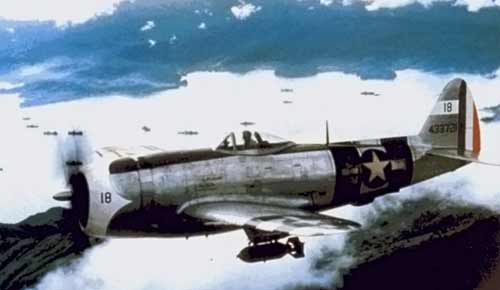 |
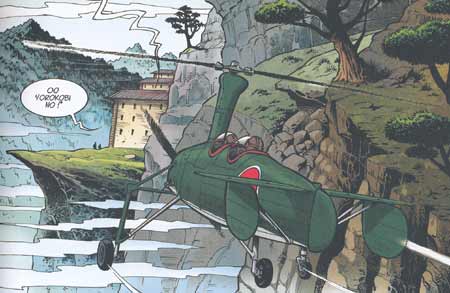 |
The Japanese autogyro Kayaba Ka-1 is well represented by Arroyo in the story LES FANTôMES DU SOLEIL LEVANT |
The Kayaba Ka-1 was a Japanese autogyro, seeing service during World War II.The Imperial Japanese Army developed the Ka-1 autogyro for reconnaissance, artillery-spotting, and anti-submarine uses. The Ka-1 was based on an American design, the Kellett KD-1A, which had been imported to Japan in 1939, but which was damaged beyond repair shortly after arrival. The Kayaba Industry was then asked by the Army First to develop a similar machine, and the first prototype was flying on 26 May 1941. The craft was initially developed for use as an observation platform and for artillery spotting duties. The Japanese Army liked the craft's short (30m) take-off span, and its low maintenance requirements. The production began in 1941 and the first autogyros were assigned to artillery units for artillery spotting. These carried two crewmen: a pilot and a spotter. The prototype, Ka-1 was essentially the repaired Kellett KD-1A. The Ka-1 had a change of the engine to the 240 hp Argus As 10c. But only about 20 Ka-1 were made. The Ka-1 employed similar aspects to the Focke-Wulf Fw 61, which was first flown in 1936. The production of the remainder were all Ka-2. The Ka-2 returned to the same Jacobs L-4MA-7 engine as the Kellett KD-1. Total Ka-1 and Ka-2 production was erroneously stated as approximately 240 by. During the production, a shortage of critical components for rotor and engine resulted in severe delivery delays. A total of 98 Ka-1 and Ka-2 airframes were produced until end of war, of them 12 was destroyed by exposure before being delivered to army and about 30 never had an engine installed, leaving about 50 delivered to IJA and about 30 actually deployed.
|
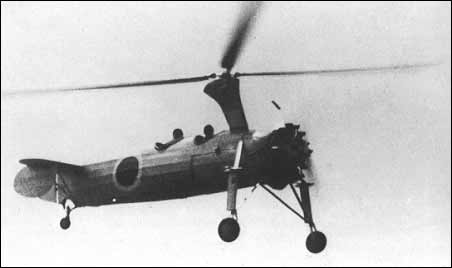 |
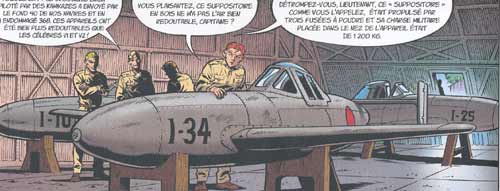 |
Some Japanese rocket powered human-guided anti-shipping kamikaze attack plane Yokosuka MXY7 Ohka are well represented by Arroyo in the story LES FANTôMES DU SOLEIL LEVANT and L'ILE DU DIABLE |
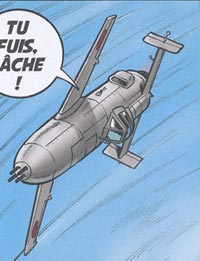 |
An experimental modified fighter version of the human-guided kamikaze attack plane Yokosuka MXY7 Ohka is shown by Arroyo in the story L'ILE DU DIABLE |
The Yokosuka MXY-7 Ohka ("cherry blossom";) was a purpose-built, rocket powered human-guided anti-shipping kamikaze attack plane employed by Japan towards the end of World War II. United States sailors gave the aircraft the nickname Baka (Japanese for "fool" or "idiot").The MXY-7 Navy Suicide Attacker Ohka was a manned flying bomb that was usually carried underneath a Mitsubishi G4M2e "Betty" Model 24J bomber to within range of its target. On release, the pilot would first glide towards the target and when close enough he would fire the Ohka's three solid-fuel rockets, one at a time or in unison, and fly the missile towards the ship that he intended to destroy.
The design was conceived by Ensign Mitsuo Ohta, aided by students of the Aeronautical Research Institute at the University of Tokyo. Ohta submitted his plans to the Yokosuka research facility. The Imperial Japanese Navy decided the idea had merit and Yokosuka engineers of the Yokosuka Naval Air Technical Arsenal (Dai-Ichi Kaigun Koku Gijitsusho, or in short Kugisho) created formal blueprints for what was to be the MXY7. The only variant which saw service was the Model 11, and it was powered by three Type 4 Mark 1 Model 20 rockets. 155 Ohka Model 11s were built at Yokosuka, and another 600 were built at the Kasumigaura Naval Air Arsenal.
The final approach was almost unstoppable because the aircraft gained high speed (650 km/h (400 mph) in level flight and 930 km/h (580 mph) or even 1,000 km/h (620 mph) in a dive). Later versions were designed to be launched from coastal air bases and caves, and even from submarines equipped with aircraft catapults, although none were actually used in this way. It appears that the operational record of Ohkas includes three ships sunk or damaged beyond repair and three other ships with significant damage. Seven U.S. ships were damaged or sunk by Ohkas throughout the war. The USS Mannert L. Abele was the first Allied ship to be sunk by Ohka aircraft, near Okinawa on 12 April 1945
|
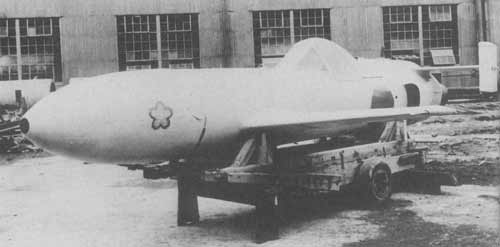 |
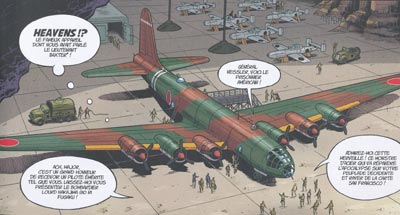 |
A Japanese ultra-long-range heavy bomber Nakajima G10 N1 Fugaku is well represented in the story L'ILE DU DIABLE.
In the reality this aircraft was never built. |
The Nakajima G10N Fugaku, was a planned Japanese ultra-long-range heavy bomber designed during World War II. It was conceived as a method for mounting aerial attacks from Japan against industrial targets along the West Coast (e.g., San Francisco), Midwestern (e.g., Detroit, Chicago, and Wichita) and Northeastern (e.g., New York and Norfolk) of the United States. Japan's worsening war situation resulted in the project's cancellation in 1944 and no prototype was ever built.
The Fugaku had its origins in "Project Z", a 1942 Imperial Japanese Army specification for an intercontinental bomber which could take off from the Kuril Islands, bomb the continental United States, then continue onward to land in German-occupied France. Once there, it would be refitted and make another return sortie.
Project Z called for three variations on the airframe: heavy bomber, transport (capable of carrying 300 troops), and a gunship armed with forty downward-firing machine guns in the fuselage for intense ground attacks at the rate of 640 rounds per second (i.e. 38400 rounds per minute).
|
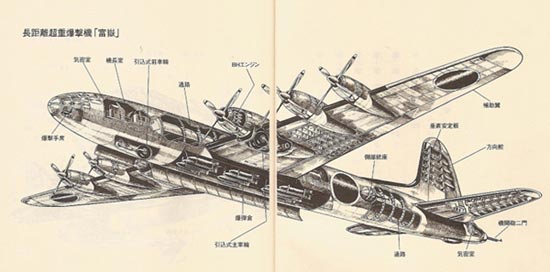 |
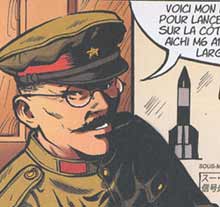 |
In the story LES FANTôMES DU SOLEIL LEVANT what seems to be a German balistic missile developed at the end of WWII is shown on a display project by the secret nazi-japanese society "Les Fantomes du Sol Levant". This fanatic group has the purpose to continue the WWII attacking the Unite States using atomic bomb, and anthrax. |
The Aggregat series was a set of ballistic missile designs developed in 1933–45 by a research program of Nazi Germany's army (Wehrmacht). Its greatest success was the A4, more commonly known as the V-2. The German word Aggregat refers to a group of machines working together: A1, A2, A3,A4 (V-2), A5, A6, A7, A8, A9/10, A11, A12
|
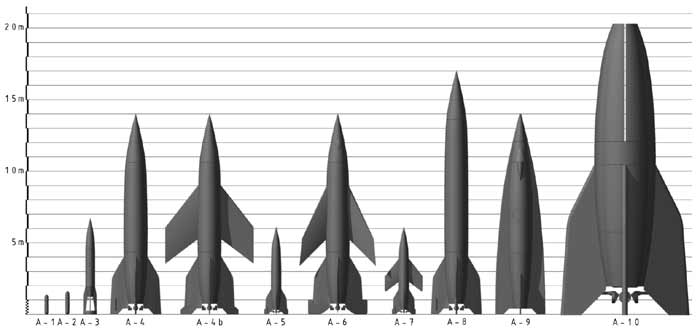 |
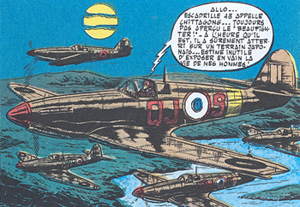 |
In the story TIGRES VOLANTS some British fighters Supermarine Spitfire are well depicted. |
Some Spitfire Mk IX variant are also shown in the adventures LES TRAFIQUANTS DE LA MER ROUGE and LES GANGSTERS DU PETROLE
|
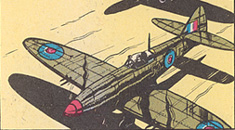 |
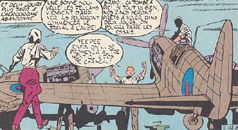 |
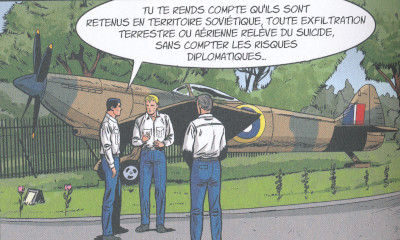 |
In the Buck Danny classic#9 a british Supermarine Spitfire is show as "gate guardian" during the late of the 50s in a RAF Air Base. |
Some Spitfire are also used for a war movie in the Buck Danny classic#11 adventure L'OMBRE ROUGE and ATOMIC CITY
|
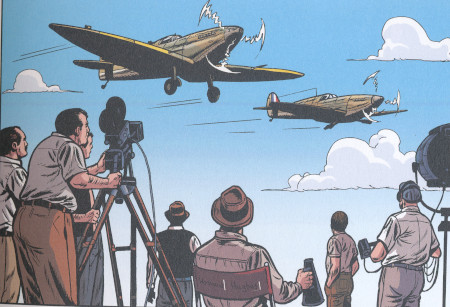 |
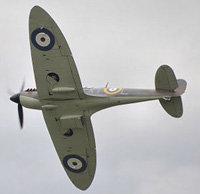 |
The Supermarine Spitfire was a British single-seat fighter aircraft, used by the Royal Air Force and many other Allied countries during the Second World War, and into the 1950s. It was produced in greater numbers than any other Allied design. The Spitfire was the only Allied fighter in production at the outbreak of the Second World War that was still in production at the end of the war.
It was armed with 8x 0.303 inch (7.7 mm) Browning machine guns, 350 rounds per gun
In the later versions (VB on)
2× 20 mm (0.787 in) Hispano Mk II cannon, 60 (later 120 (Mk VC)) shells per gun
4× 0.303 inch (7.7 mm) Browning machine guns, 350 rounds per gun
and 2× 250 lb (110 kg) bombs
|
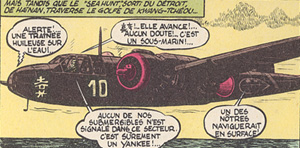 |
In the story ATTAQUE EN BIRMANIE an US Navy submarine is attacked by a Japanese bomber Mitsubishi G3M "Nell". |
Some Mitsubishi G3M are also used by the Malaysia pirates against the US Navy support base of the Buck Danny's squadron in the story LE TIGRE DE MALAISIE
|
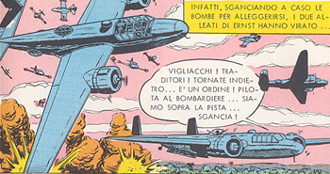 |
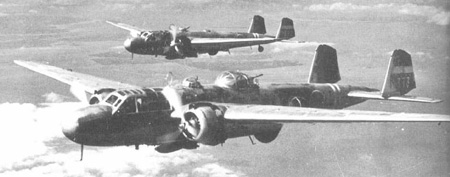 |
The Mitsubishi G3M Type 96 land-based attack aircraft; Allied reporting name "Nell" was a Japanese bomber aircraft used during World War II, mostly against the Chinese. The bomber had a crew of five, and had its first flight in July 1935. The aircraft was armed with three 7.7mm machine guns. Maximum speed was 188 knots and had a range of over 2,200 miles. The G3M was also designed to carry an 800 kg torpedo for ship attacks.
|
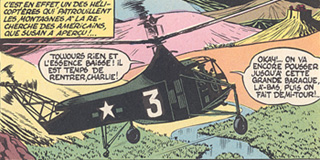 |
In the story ATTAQUE EN BIRMANIE the first US Army Aviation helicopter the Sikorsky R-4 Hoverfly is well represented. This helicopter actually was first used in combat in May 1944. |
The Sikorsky R-4 was the world's first mass produced helicopter and the United States Air Force's first service helicopter. Its performances were; Maximum speed: 75 mph (120 km/h), Cruise speed: 65 mph (105 km/h) and Service ceiling 8,000 ft (2400 m)
|
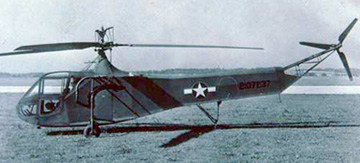 |
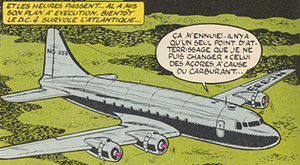 |
A civilian aircraft Douglas DC-4 is well depicted in the story LES TRAFIQUANTS DE LA MER ROUGE. |
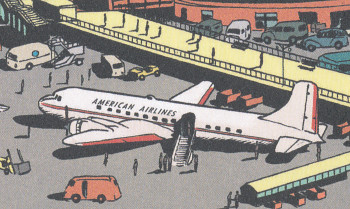 |
A civilian aircraft Douglas DC-4 is represented in the New York airport La Guardia in the story BUCK DANNY ORIGINES - LE PILOTE A L'AILE BRISEE. |
The DC-4 is a four-engined propeller-driven airliner developed by the United States company Douglas Aircraft Company. It served during the Second World War in a military role, and after the war for civilian airlines. The DC-4 had a notable innovation in that its nosewheel landing gear allowed it to incorporate a fuselage of constant cross-section for most of its length. This lent itself to easy stretching into the later DC-6 and DC-7. A total of 1,163 C-54/R5Ds were built for the United States military services between 1942 and January 1946.
|
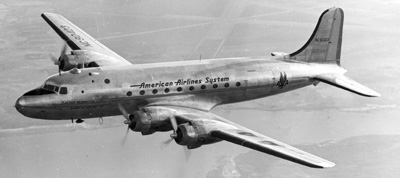 |
|
Boulton Paul Balliol T.Mk2 |
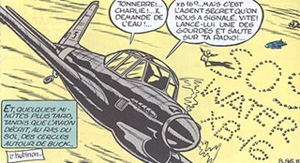 |
In the story LES PIRATES DU DESERT the British advanced trainer Boulton Paul Balliol T.Mk2 is shown. |
The Boulton Paul Balliol and the related Sea Balliol were monoplane military advanced trainer aircraft built during the late 40s for the United Kingdom's Royal Air Force (RAF) and the Royal Navy Fleet Air Arm (FAA) by Boulton Paul Aircraft. The Balliol was designed to replace the North American Harvard trainer and used the Rolls-Royce Merlin engine, with the Sea Balliol a naval version with folding wings and arrestor hook for training in deck landing.
|
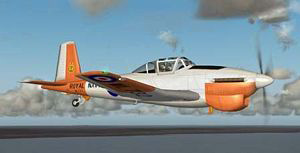 |
|
De Havilland Mosquito B.Mk IV |
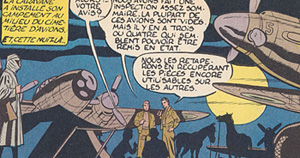 |
In the story LES GANGSTERS DU PETROLE a De Havilland Mosquito seems to be one of the dismissed aircraft placed in a storage area in the Arabian desert. |
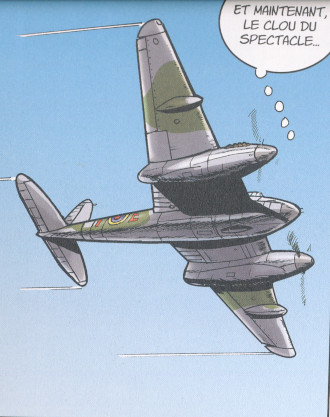 |
A De Havilland Mosquito is also represented in the "classic" adventure ATOMIC CITY. |
The De Havilland Mosquito was a British combat aircraft that excelled in a number of roles during the Second World War. Originally conceived as an unarmed fast bomber, uses of the Mosquito included: low to medium altitude daytime tactical bomber, high altitude night bomber, pathfinder, day or night fighter, fighter-bomber, intruder, maritime strike and photo reconnaissance aircraft. It was also used as the basis for a single-seat heavy fighter, the De Havilland Hornet. The aircraft served with the Royal Air Force (RAF) and many other air forces during the Second World War and postwar.
|
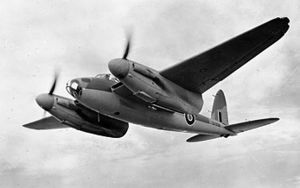 |
|
Chance Vought F4U Corsair |
 |
A Vought F4U Corsair is partially visible in one drawing of the story PATROUILLE A L'AUBE. The Corsair was located in an old aircraft cemetery of a pacific island with other WW II aircraft like B-17, Avenger, B-25 and a not well identified Jet of the early 50s.
|
A Vought F4U Corsair is well represented in the first story of the new "Classic" Adventures of Buck Danny titled SABRE SUR LA COREE.
|
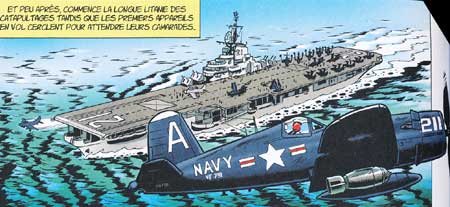 |
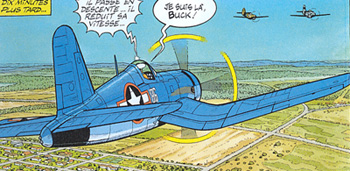 |
A fully restored Vought F4U Corsair is well represented in the adventure SABOTAGE AU TEXAS. This aircraft is part of the warbirds collection belong to one of the Sonny's fiancee Lucy "Lulubelle" widow of the rich Texan oilman Hawk.
|
Some Vought F4U Corsair are visible in the story of the new "Classic" Adventures of Buck Danny titled L'ILE DU BIABLE.
|
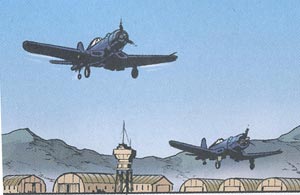 |
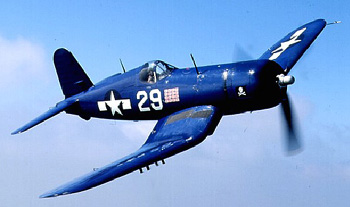 |
The Chance Vought F4U Corsair was a carrier-capable fighter aircraft that saw service in World War II and the Korean War (and in isolated local conflicts). The Corsair served in some air forces until the 1960s, following the longest production run of any piston-engined fighter in U.S. history (1942–1952). Some Japanese pilots regarded it as the most formidable American fighter of World War II. The U.S. Navy counted an 11:1 kill ratio for every F4U shot down. It as armed with; Guns: 4× 0.50 in (12.7 mm) M2 Browning machine guns, 400 rounds per gun
2× 0.50 in Browning M2 machine guns, 375 rounds per gun
Rockets: 4× 5 in (12.7 cm) High Velocity Aircraft Rockets and/or
Bombs: 2,000 lb (910 kg)
|
|
Boeing-Stearman Model 75 "Kaydet" |
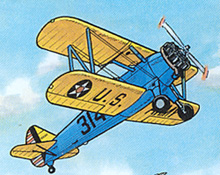 |
A fully restored biplane Boeing-Stearman Model 75 "Kaydet" is flying during the Air-show in the story SABOTAGE AU TEXAS. |
A Stearman Model 75 is also whow by De Luca in the story BUCK DANNY ORIGINES - LE FILS DU VIKING NOIR. This aircraft was the first one flying by a young Buck Danny when he was working in a flying circus during the middle of the 30s.
|
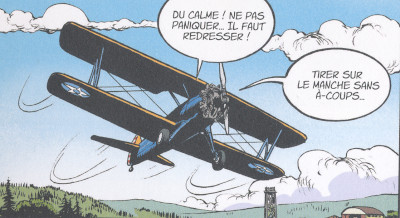 |
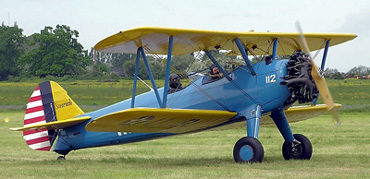 |
The Stearman (Boeing) Model 75 is a biplane, of which 8584 were built in the United States during the 1930s and 1940s as a military trainer aircraft. Stearman became a subsidiary of Boeing in 1934. Widely known as the Stearman, Boeing-Stearman or Kaydet, it served as a Primary trainer for the USAAF, as a basic trainer for the USN, and with the RCAF as the Kaydet throughout World War II. After the conflict was over, thousands of surplus aircraft were sold on the civil market. In the immediate post-war years they became popular as crop dusters and as sports planes.
|
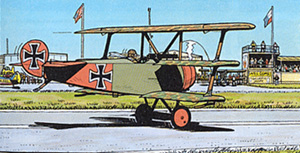 |
A fully restored WW I triplane Fokker Dr. I is presented during the Air-show in the story SABOTAGE AU TEXAS. |
The Fokker Dr.I Dreidecker (triplane) was a World War I fighter aircraft built by Fokker-Flugzeugwerke. The Dr.I saw widespread service in the spring of 1918. It became renowned as the aircraft in which Manfred von Richthofen (The Red Baron) gained his last 20 victories, and in which he was killed on 21 April 1918.
|
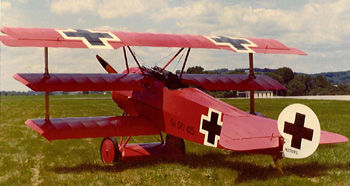 |
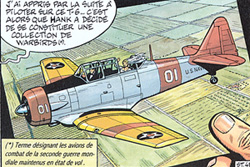 |
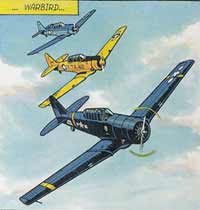 |
A fully restore North American T-6 Texan is shown in the story SABOTAGE AU TEXAS. Also this This aircraft is part of the warbirds collection belong to one of the Sonny's fiancee Lucy "Lulubelle" widow of the rich Texan oilman Hawk.
In the same story other restore T-6 are flying during the Air-show. |
A North American T-6 Texan seems also represented in the "classic" story ATOMIC CITY. |
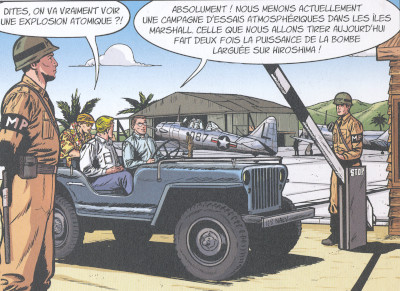 |
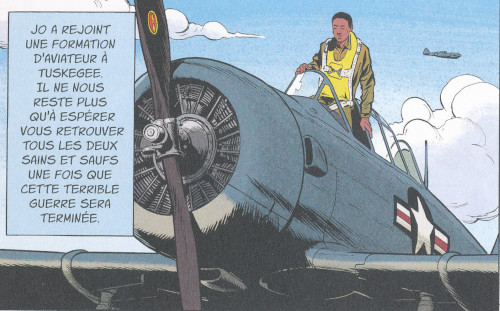 |
A North American T-6 Texan is also shown in the "origns" story LETTRES À JO. |
The T-6 Texan was a single-engine advanced trainer aircraft designed by North American Aviation, used to train fighter pilots of the United States Army Air Forces, United States Navy, Royal Air Force and other air forces of the British Commonwealth during World War II. The T-6 is known by a variety of designations depending on the model and operating air force. The USAAC called it the AT-6, the US Navy, the SNJ, and British Commonwealth air forces, the Harvard. It remains a popular warbird aircraft.
|
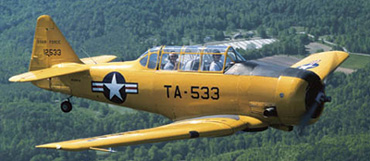 |
|
Waco Aircraft Company YKS-6 (UC-72) |
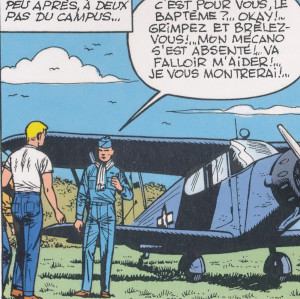 |
In the humoristic and fantasy short story by Charlier and Hubinnon C'ETAIT EN 38... IN 1938 during the College in California Buck Danny, Sonny Tuckson and Jerry Tumbler are flying for the first time on a Waco YKS-6 (UC-72) as promotional flight experience promoted by the US Air Army.
Of course this story is a fantasy and humoristic scenarion being the three pilot never attending the College together and never meet each other before the WWII. |
The Waco S Series is a family of American cabin biplanes produced by the Waco Aircraft Company starting in 1935. The S series proved to be popular with both commercial and private pilots and over 50 were still airworthy in 2001, including examples of the CPTP VKS-7F version. During the Second World War several S series aircraft were impressed by the USAAF as the UC-72K or UC-72M and used as Liaison, executive light transport and instrument refresher training aircraft. Only a handful remain airworthy in this century..
|
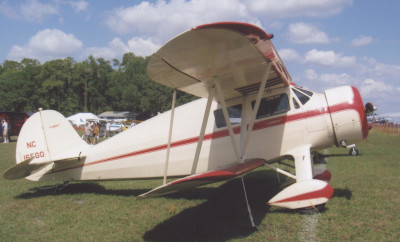 |
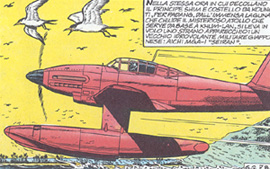 |
In the story GHOST QUEEN Lady X is flying an old WW II Japanese submarine-launched floatplane Aichi M6A1 Seiran. |
The Aichi M6A Seiran was a submarine-launched attack floatplane designed for the Imperial Japanese Navy. It was intended to be used with the I-400, a 4500-ton submarine dubbed a "submersible aircraft carrier". Two to three of the craft would be stowed aboard in disassembled form, and launched by catapult. The twin floats could be jettisonned, and the aircraft was essentially meant to be ditched at sea upon completion of its mission.
|
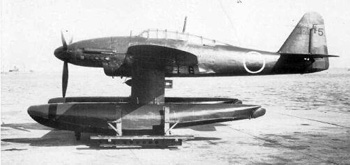 |
|
Douglas C-118 Liftmaster / DC-6 |
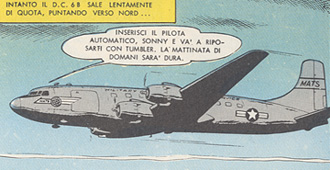 |
The military version of the transport aircraft DC-6 designated C-118 Liftmaster is well depicted in the story NC 22654 NE REPOND PLUS. |
An USAF C-118 Liftmaster is well depicted by Arroyo Buck Danny classic #5 and #6 OPERATION RIDEAU DE FER and ALERTE ROUGE. |
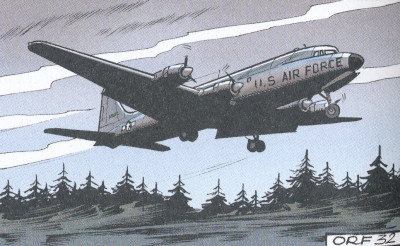 |
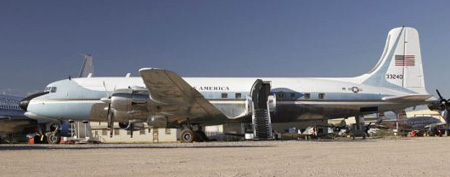 |
The Douglas DC-6 is a piston-powered airliner and transport aircraft built by the Douglas Aircraft Company from 1946 to 1959. Originally intended as a military transport near the end of World War II, it was reworked after the war to compete with the Lockheed Constellation in the long-range transport market. More than 700 were built, and many still fly today in cargo, military, and wildfire control roles.
The DC-6 was known as the C-118 Liftmaster in United States Air Force service, and as the R6D in United States Navy service.
|
|
Bucker Bu 133 Jungmeister |
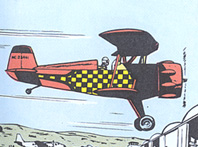 |
In the story S.O.S. SOUCOUPES VOLANTES! Slim Holden makes his first apperance on board of the aerobatic aircraft Bucker Bu 133 Jungmeister |
The Bucker Bu 133 Jungmeister is also used both by Slim Holden and Buck Danny during a pilot skilled challenge in the story PROTOTYPE FX-13.
|
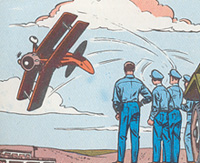 |
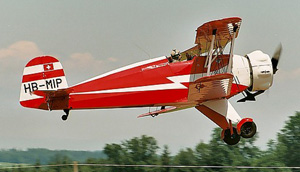 |
With two wings and a round engine, the Bucker Bu-133 Jungmeister, designed as an advanced aerobatic single-seat trainer, is truly the epitome of an aerobatic biplane. This masterpiece of Carl Bucker's German company, Bucker Flugzeugbau GmbH, rolled out of the factory in early 1935, two years after the introduction of the company's highly successful two-seat biplane trainer, the Bu-131 Jungmann.
|
|
Beech Aircraft C-45 Expeditor / Beechcraft 18 "Twin Beech" |
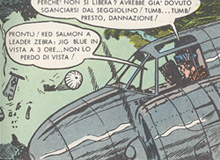 |
In the story PILOTES D'ESSAI Buck Danny and an USAF instructor are flying the twin-engine Beech Aircraft C-45 Expeditor. |
The civilian variant of the C-45 designated Beechcraft Model 18 is well depicted in the adventures TOP SECRET and MISSION VERS LA VALLEE PERDUE
|
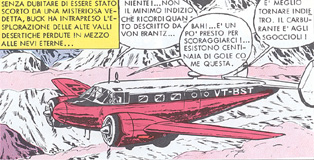 |
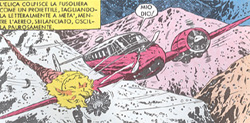 |
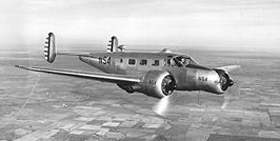 |
The Beechcraft Model 18, or "Twin Beech", as it was better known, is a 6-11 place, twin-engine, low-wing, conventional-gear aircraft that was manufactured by the Beech Aircraft Corporation of Wichita, Kansas. This model saw military service during and after World War II in a number of versions including the United States Army Air Forces (USAAF) C-45 Expeditor, AT-7 Navigator, AT-11 Kansan; and for the United States Navy (USN), UC-45J Navigator and the SNB-1 Kansan. The aircraft's uses have included aerial spraying, sterile bug release, fish seeding, dry ice cloud seeding, aerial firefighting, airborne mail pick up and drop, ambulance service, numerous movie productions, skydiving, freight, gun- and drug-smuggling, engine test bed, skywriting and banner towing.
|
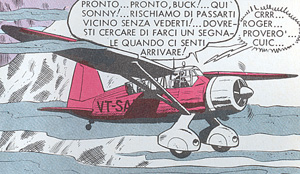 |
In the story MISSION VERS LA VALLEE PERDUE Sonny Tuckson and Jerry Tumbler also flying a Westland Lysander |
The Westland Lysander was a British army co-operation and liaison aircraft produced by Westland Aircraft. It was used during the Second World War and was renowned for its ability to operate from small, unprepared airstrips. The aircraft's exceptional short-field performance made possible clandestine missions behind enemy lines that placed or recovered agents, particularly in occupied France.
|
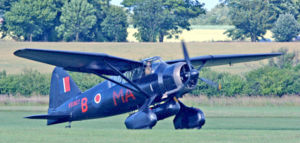 |
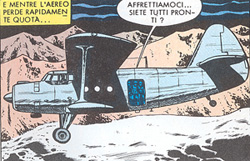 |
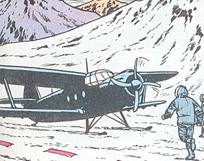 |
In the story MISSION VERS LA VALLEE PERDUE a couple of Antonov An-2 "Colt" both with normal gear and with skis are depicted |
An Antonov An-2 is shown also in the first story of the new "Classic" Adventures of Buck Danny titled SABRE SUR LA COREE
|
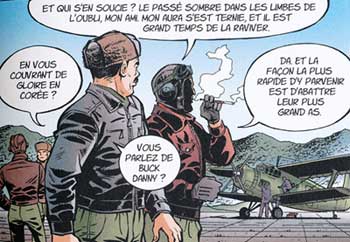 |
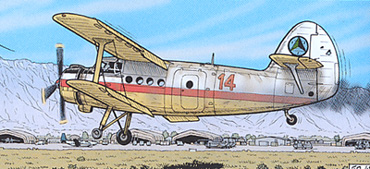 |
An Antonov An-2 used by Sonny Tuckson during the rescue mission in Afghanistan is also well depicted in the story PORTE DISPARU
|
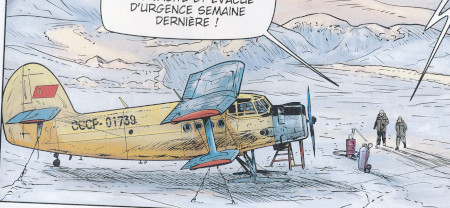 |
An Antonov An-2 is well represented by Formosa in the adventure VOSTOK NE REPOND PLUS
|
The Antonov An-2 NATO code name Colt is an extremely durable, light, single-engine biplane which first flew in 31 August 1947 and was the first plane designed by Antonov. It is used as a light transport, capable of carrying 12 passengers, and for parachute drops and agricultural work. Its extraordinary slow-flight and STOL capabilities make it supremely suited for short, unimproved fields, and some specialized variants have also been built for cold weather and other extreme environments.
|
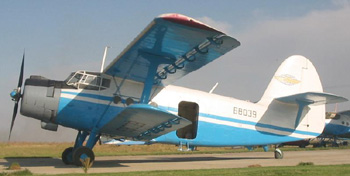 |
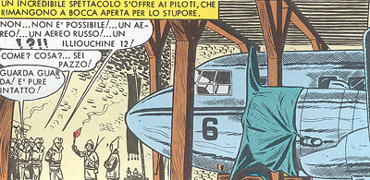 |
A russian transport aircraft Ilyushin IL-12 "Coach" is partially visible in the story MISSION VERS LA VALLEE PERDUE |
The Ilyushin Il-12 (NATO reporting name "Coach") was a Soviet twin-engined cargo aircraft, developed in the mid-1940s for Aeroflot. The aircraft was intended to replace the Lisunov Li-2, which was a licence produced version of the Douglas DC-3. The new aircraft followed a classical layout for a twin engined transport, with a metallic structure, monoplane wings, a conventional tail section. One major improvement over the Li-2 design was the tricycle gear, which allowed better visibility when taxiing and landing. It had increased wing surface compared with the DC-3/Li2, which was necessary owing to the increased power. |
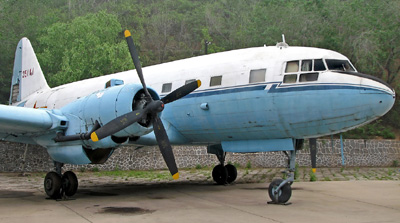 |
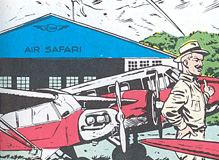 |
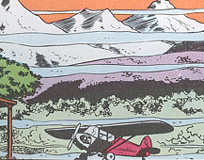 |
In the stories TOP SECRET and MISSION VERS LA VALLEE PERDUE a Piper J-3 Cub is partially visible |
The nose of a Piper J-3 Cub is partially visible also in a drawing of the story LES VOLEURS DE SATELLITE
|
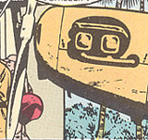 |
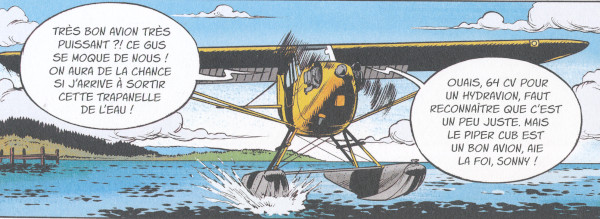 |
In the "origins" story LETTRES À JP the seaplane version of the Piper J-3 Cub is represented |
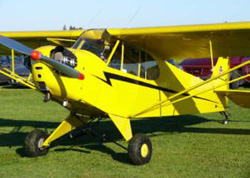 |
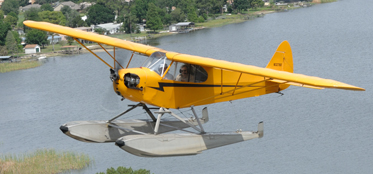 |
The Piper J-3 Cub is a small, simple, light aircraft that was built between 1937 and 1947 by Piper Aircraft. With tandem (fore and aft) seating, it was intended for flight training but became one of the most popular and best-known light aircraft of all time. The Cub's simplicity, affordability and popularity invokes comparisons to the Ford Model T automobile. Its standard yellow paint has come to be known as "Cub Yellow" or "Lock Haven Yellow".
|
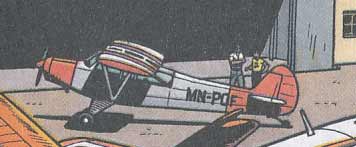 |
In the stories ZONE INTERDITE a Piper PA-18 Super Cub is probably shown by Bergese |
A Piper PA-18 Super Cub is probably also visible in the story SABOTAGE AU TEXAS
|
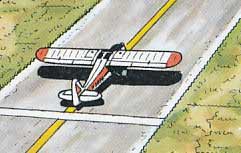 |
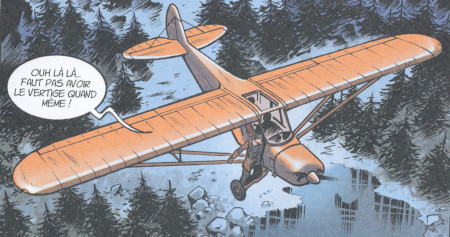 |
A Piper PA-18 Super Cub is also represented by Arroyo in the Buck Danny classic #5 OPERATION RIDEAU DE FER
|
some Piper PA-18 Super Cub are probably also visible in the story MOLOTOK-41 NE REPOND PLUS
|
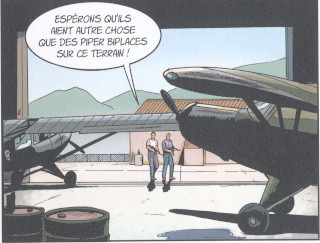 |
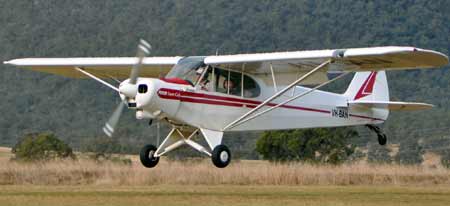 |
The Piper PA-18 Super Cub is a two-seat, single-engine monoplane. Introduced in 1949 by Piper Aircraft, it was developed from the Piper PA-11, and traces its lineage back through the J-3 to the Taylor E-2 Cub of the 1930s. In close to 40 years of production, over 9,000 were built. Super Cubs are commonly found in roles such as bush flying, banner and glider towing
|
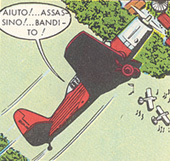 |
The Sonny's fiancee and her mother get their firt "orientation flight" on a Vought OS2U Kingfisher in the story PROTOTYPE FX-13 |
The Vought OS2U Kingfisher was a American catapult-launched observation floatplane. It was a compact mid-wing monoplane, with a big central float and small stabilizing floats. Performance was modest, because of its light engine. The OS2U could also operate on fixed, wheeled, taildragger landing gear.
|
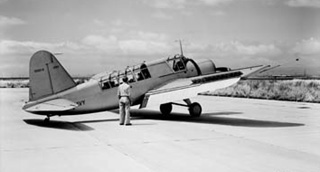 |
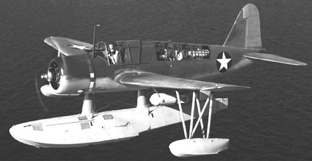 |
The OS2U was the main shipboard observation aircraft used by the United States Navy during World War II, and 1,519 of the aircraft were built. It served on battleships and cruisers of the US Navy, and with the US Coast Guard, the Royal Navy and the Soviet Navy. The Royal Australian Air Force also operated a few Kingfishers from shore bases.
|
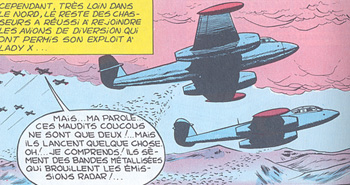 |
Two Gloster Meteor are used by the pilots of the Lady X's criminal organisation in the story BUCK DANNY CONTRE LADY X |
Two Argentinian Air Force Gloster Meteor are show in the Classic #7 story SEA DART |
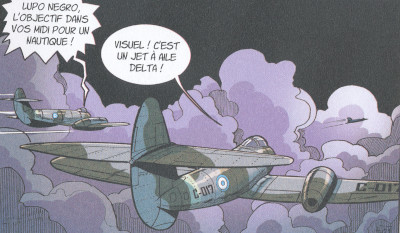 |
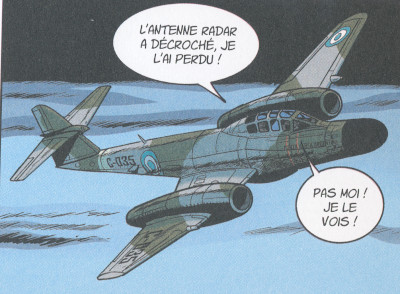 |
In the same adventure SEA DART the night fighter variant NF.11 of the Meteor is also shows. Indeed this variant in the reality was not used by Argentinian Air Force |
The Gloster Meteor was the first British jet fighter and the Allies' first operational jet. Designed by George Carter, it first flew in 1943 and commenced operations on 27 July 1944 with 616 Squadron of the Royal Air Force (RAF). The Gloster Meteor was not an aerodynamically advanced aircraft but the Gloster design team succeeded in producing an effective jet fighter that served the RAF and other air forces for decades. Meteors saw action with the Royal Australian Air Force (RAAF) in the Korean War and remained in service with numerous air forces until the 1970s.
|
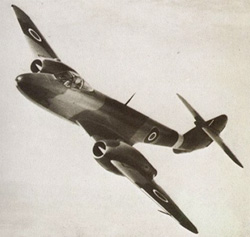 |
|
Lockheed P-80 (F-80) Shooting Star |
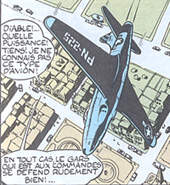 |
An F-80 Shooting Star is visible in the story PILOTES D'ESSAI where for the first time Buck Danny and his comrades are trained to fly the new generaton of jet fighters. |
Buck Danny and his USAF group try to reach the Korean war area with their F-80 in the story CIEL DE COREE.
|
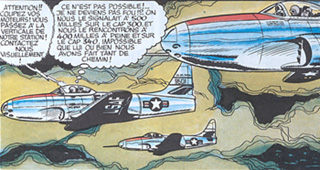 |
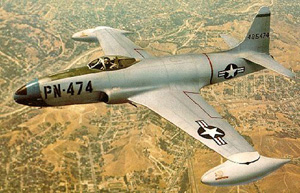 |
The Lockheed P-80 Shooting Star was the first operational jet fighter used by the United States Army Air Forces, and saw extensive combat in Korea with the United States Air Force as the F-80. As one of the world's first successful turbojet-powered combat aircraft, it helped usher in the "jet age" in the USAF and other air forces worldwide. One of its claims to fame is in training a new generation of pilots, especially in its closely-related T-33 Shooting Star trainer development. It was armed with 6x 0.50 in (12.7 mm) machine guns (300 rounds per gun, 1,800 rounds total) 2x 1,000 lb (454 kg) bombs 8x unguided rockets.
|
|
Lockheed T-33 Shooting Star |
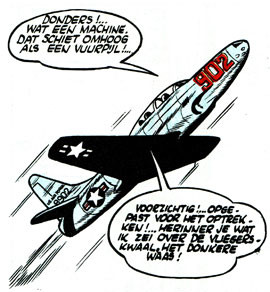 |
In the story PILOTES D'ESSAI Sonny Tuckson made his first flight on a Jet aircraft on board of a Lockheed T-33 Shooting Star. |
A T-33 is also well depicted in the story UN AVION N'EST PAS RENTRE.
|
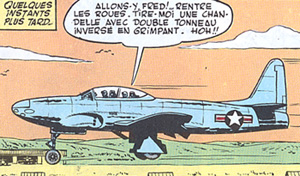 |
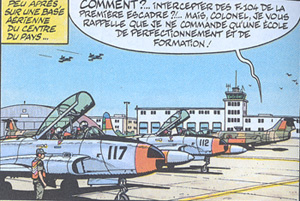 |
Some Lockheed T-33 Shooting Star belong to the Managua Air Force are shown in the story TONNERRE SUR LA CORDILLERE
|
A Lockheed T-33 Shooting Star is also well represented by Le Bras in the second episode of the story LES OISEAUX NOIRS
| 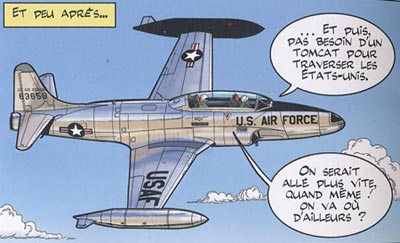 |
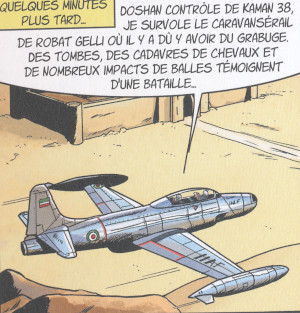 |
Some Lockheed T-33 Shooting Star belong to the Iranian Air Force are shown in the story MOLOTOK-41 NE REPOND PLUS
|
The Lockheed T-33 Shooting Star is an American-built jet trainer aircraft. It was produced by Lockheed and made its first flight in 1948, piloted by Tony LeVier. The T-33 was developed from the Lockheed P-80/F-80 starting as TP-80C/TF-80C in development, then designated T-33A. It was used by the USN as the initially as TO-2 then TV-2 and after 1962, T-33B. Despite its vintage, the venerable T-33 still remains in service worldwide.
| 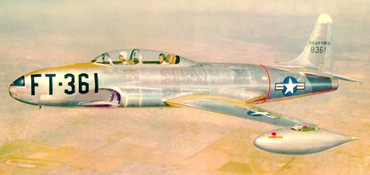 |
|
Remote Piloted Aerial Target |
 |
Unidentify Remote Piloted Aerial Target is used in the story PILOTES D'ESSAI |
Another similar unidentify Remote Piloted Aerial is shown in the story AVIONS SANS PILOTES.
|
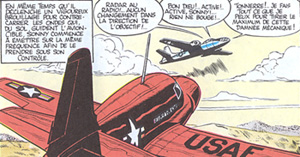 |
|
Boeing B-29 Superfortress |
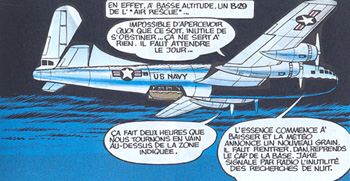 |
A B-29 In configuration US Navy SAR is shown in the story CIEL DE COREE |
The Boeing B-29 Superfortress in the variant of motheship for the Experimental Rocket Aircraft XS-1 is depicted in the story PILOTES D'ESSAI. For the X-1 program was also used as mothership the B-29 version with larger Pratt & Whitney R-4360 radial engines, a taller vertical stabilizer, and other improvements designated as B-50.
|
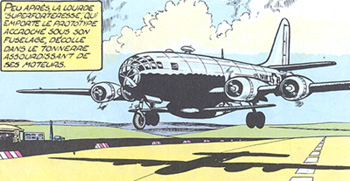 |
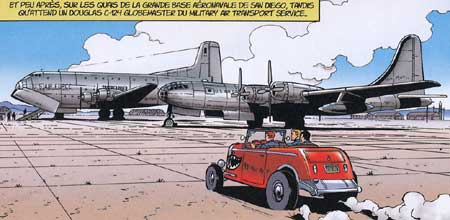 |
A Boeing B-29 or a B-50 is also shown in the first story of the new "Classic" Adventures of Buck Danny titled SABRE SUR LA COREE
|
Some Boeing B-29 are well represented by Arroyo in the adventures of the new "Classic" Buck Danny titled LES FANTôMES DU SOLEIL LEVANT and L'ILE DU DIABLE
|  |
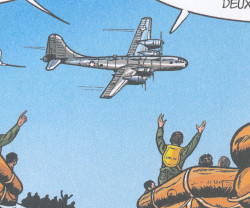 |
A Boeing B-29 in SAR configuration is also represented in the Buck Danny classic #9 LE VOL DU RAPIER
|
A Boeing B-29 is well represented by LeBras in the adventure of the "Classic" Buck Danny #12 titled ATOMIC CITY
| 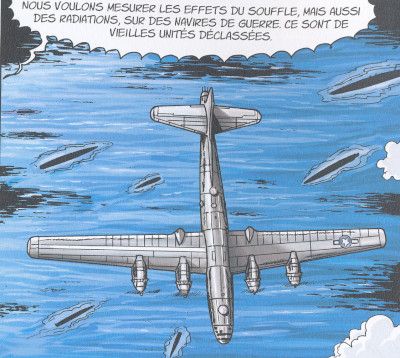 |
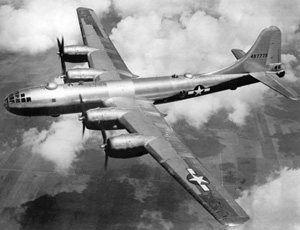 |
The Boeing B-29 Superfortress was a four-engine propeller powered heavy bomber that was flown by the United States Military in World War II and the Korean War, and by other nations afterwards. The name "SuperfortressB-17 Flying Fortress, and carried on a series of names for Boeing-built bombers followed by the B-52 Stratofortress.
The B-29 was one of the largest airplanes to see service during World War II. It was one of the most advanced bombers of its time, featuring innovations such as a pressurized cabin, a central fire-control system, and remote-controlled machine-gun turrets. Though it was designed as a high-altitude daytime bomber, in practice it actually flew more low-altitude nighttime incendiary bombing missions. It was the primary aircraft in the U.S. firebombing campaign against the Empire of Japan in the final months of World War II, and B-29s carried the atomic bombs that destroyed Hiroshima and Nagasaki.
|
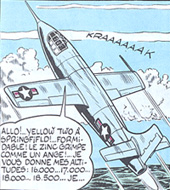 |
In the story PILOTES D'ESSAI Buck Danny is also flying the Experimental Rocket Aircraft Bell X-1. In the reality the flight tests of this early Experimental Aircraft were conducted at Muroc Army Air Field (later Edwards AFB) In the California desert. |
The Bell X-1, originally designated XS-1, was a joint NACA-U.S. Army Air Forces/US Air Force supersonic research project and the first aircraft to exceed the speed of sound in controlled, level flight piloted by Air Force Captain Charles "Chuck" Yeager in aircraft #46-062, which he had christened "Glamorous Glennis", after his wife. This resulted in the first of the so-called X-planes, an American series of experimental aircraft designated for testing of new technologies and usually kept highly secret.
|
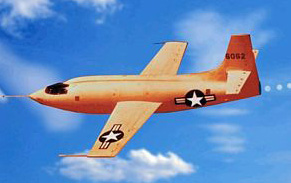 |
|
Douglas D-558-II Skyrocket |
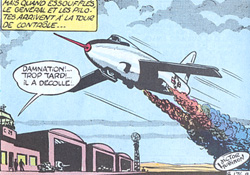 |
In the story PILOTES D'ESSAI Buck Danny is also flying the Experimental Rocket Aircraft D-558-II Skyrocket. Also in this case in the reality the flight tests of this early Experimental Aircraft were conducted at Muroc Army Air Field (later Edwards AFB) In the California desert. |
The Douglas Skyrocket (D-558-2 or D-558-II) was a rocket and jet-powered supersonic research aircraft built by the Douglas Aircraft Company for the United States Navy. On November 20, 1953, shortly before the 50th anniversary of powered flight, Scott Crossfield piloted the Douglas D-558-2 Skyrocket to Mach 2, or more than 1,290 mph (2076 km/h), the first time an aircraft had exceeded twice the speed of sound.
|
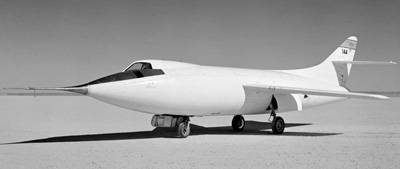 |
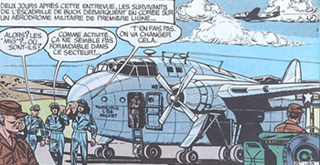 |
A transport aircraft C-82 Packet is shown in the story CIEL DE COREE. |
The C-82 Packet was a twin-engine, twin-boom cargo aircraft used briefly by the United States Army Air Forces following World War II. Developed by Fairchild, the aircraft was first flown in 1944. 223 were built, with most used for cargo and troop transport, although a few were used for paratroop operations or towing gliders. During its brief operational life several C-82 Packets were utilized during the Berlin Airlift, primarily bringing assembled vehicles into the city.
|
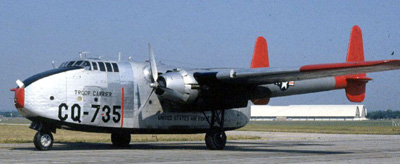 |
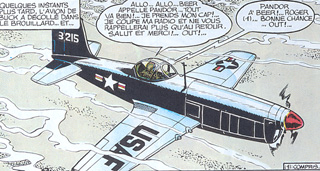 |
Buck Danny in the stories CIEL DE COREE and AVIONS SANS PILOTES is flying the experimental lightweight fighter XP-77 |
The Bell XP-77 development was initiated by the United States Army Air Corps during World War II to produce a simplified "lightweight" fighter aircraft using so-called "non-strategic" materials. Despite being innovative, the diminutive prototype proved tricky to handle and the project was canceled when the XP-77 did not deliver its projected performance.
|
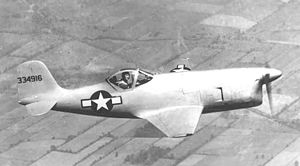 |
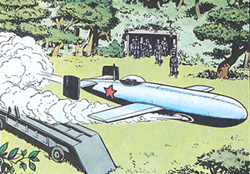 |
In the stories CIEL DE COREE and AVIONS SANS PILOTES the North Korean forces used several remote piloted flying bombs. The general design of these Flying bombs is similar to the Japanese manned flying bombs Yokosuka MXY-7 Ohka "Baka" used by the kamikaze pilots. The launch rail system and the mission profile of these Flying bombs also remind the German early cruise missile Fieseler Fi 103 better know as V1 |
The Yokosuka MXY-7 Ohka, was a purpose-built, rocket powered kamikaze aircraft employed by Japan towards the end of World War II. The United States gave the aircraft the name Baka (Japanese for idiot).
It was a manned flying bomb that was carried underneath a Mitsubishi G4M Betty, Yokosuka P1Y Ginga Frances (guided Type 22) or planned Heavy Nakajima G8N Renzan Rita (transport type 43A/B) bomber to within range of its target; on release, the pilot would first glide toward the target and when close enough he would fire the Ohka's rocket engine and guide the missile towards the ship that he intended to destroy.
|
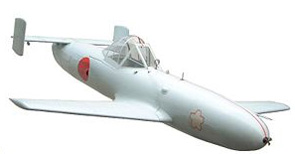 |
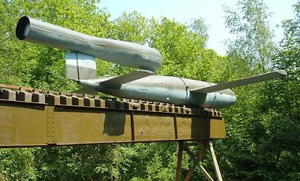 |
The Fieseler Fi 103, better known as V-1 (German: Vergeltungswaffe 1) was an early cruise missile used during World War Two. The V-1 was developed at Peenemünde by the German Luftwaffe during the Second World War. Between June 1944 and March 29, 1945, it was fired at population centers such as London and Antwerp. V-1s were launched from "ski" launch sites along the French (Pas-de-Calais) and Dutch coasts until the sites were overrun by Allied forces.
|
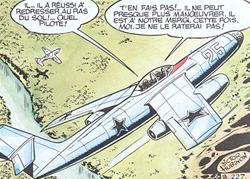 |
In the story CIEL DE COREE the north Korean forces used a two seats jet fighter aircraft identified with the fantasy designation of La-16. The general design of this aircraft is similar to the two seat prototype of the russian Soukhoi Su-9. |
The Sukhoi Su-9, or Samolet K (Russian: Aircraft K), was an early jet fighter aircraft built in the Soviet Union shortly after World War II. The Su-9 also served as the basis for the Su-11 (Samolet LK) and Su-13 (Samolet TK). While it bore a superficial resemblance to the German Messerschmitt Me 262, the Su-9 was not related to that aircraft. The first flight took place on 13 November 1946 and trials the following month proved promising. Su-9 was an advanced design for the time with an ejection seat and a provision for JATO rockets. For the first time on a Soviet aircraft, the Su-9 utilized a brake parachute and unique wing-mounted air brakes.
|
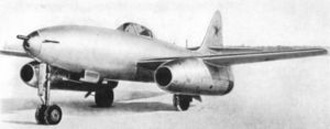 |
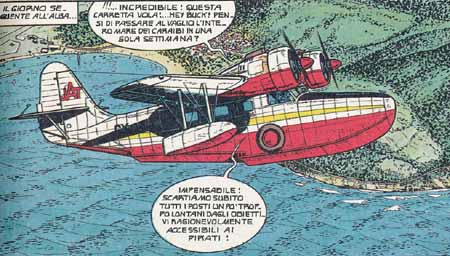 |
Buck Danny and Sonny Tuckson are flying the amphibious aircraft Grumman G-21 Goose in the story LES PILOTES DE L'ENFER . |
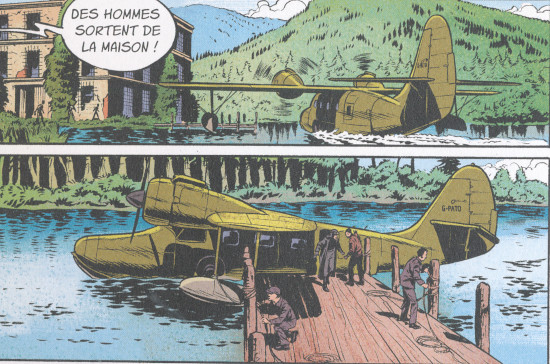 |
The amphibious aircraft Grumman G-21 Goose is also present in the "origins" story LETTRES À JO . |
The Grumman G-21 Goose amphibious aircraft was designed as an eight-seat "commuter" aircraft for businessmen in the Long Island area. The Goose was Grumman’s first monoplane to fly, its first twin-engined aircraft, and its first aircraft to enter commercial airline service. During World War II, the Goose became an effective transport for the US military (including the Coast Guard), as well as serving with many other air forces. During hostilities, the Goose took on an increasing number of combat and training roles. The adaptable transport continued in postwar use.
|
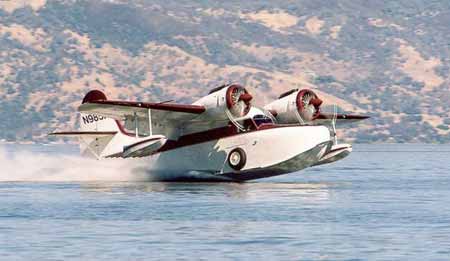 |
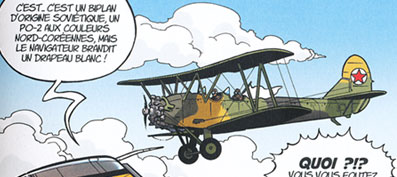 |
A Russian biplane Polikarpov Po-2 is well represented in the story DUEL SUR MIG ALLEY. |
The Polikarpov Po-2 (also U-2) served as a general-purpose Soviet biplane, nicknamed Kukuruznik, NATO reporting name "Mule". The reliable, uncomplicated concept of the Po-2's design made it an ideal training aircraft, as well as doubling as a low-cost ground attack, aerial reconnaissance, psychological warfare and liaison aircraft during war, proved to be one of the most versatile light combat types to be built in the Soviet Union. As of 1978 it remained in production for a longer period of time than any other Soviet-era aircraft.
It is one of the most produced aircraft, and may be the most produced biplane, in the history of aviation. More than 40,000 Po-2s may have been built between 1928 and 1953.
|
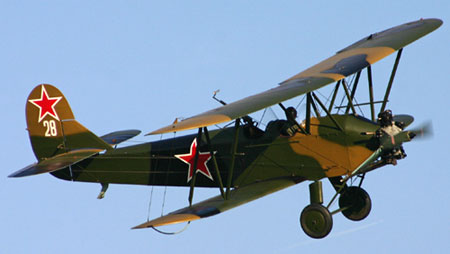 |
|
Douglas A-26 (B-26) Invader |
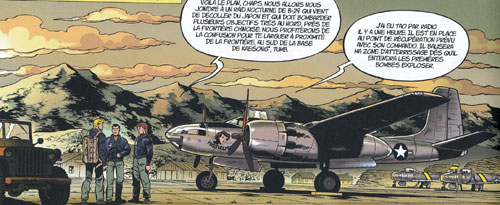 |
A Douglas A-26 (in that period already designated as B-26) Invader is well represented in the story DUEL SUR MIG ALLEY. |
The Douglas A-26 Invader (designated B-26 between 1948 and 1965) is a United States twin-engined light bomber and attack aircraft that was built by Douglas Aircraft during World War II that also saw service during several of the Cold War's major conflicts. A limited number of highly modified aircraft (designation A-26) served in combat until 1969.
It was found to be a fast aircraft capable of carrying twice its specified bomb load. A range of guns could be fitted to produce a formidable ground-attack aircraft.
The re-designation of the type from A-26 to B-26 has led to popular confusion with the Martin B-26 Marauder, a design that first flew in November 1940, some 16 months before the Douglas design's maiden flight. Although both types utilized the much-used Pratt & Whitney Double Wasp eighteen-cylinder, double-row engine, they were completely different designs. The last A-26 in active US service was assigned to the Air National Guard; that aircraft being retired from military service in 1972 by the US Air Force and the National Guard Bureau and donated to the National Air and Space Museum.
|
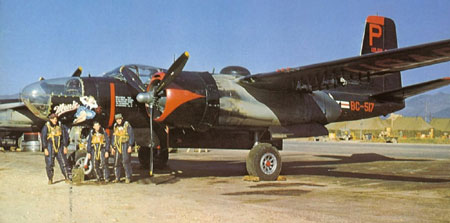 |
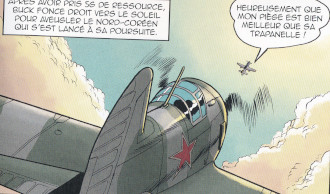 |
A Russian LA-11 is fighting against the Muastang of Buck Danny in the short adventure LES DERNIERS COMBATS during the Korean war in 1952 |
The Lavochkin La-11 (NATO reporting name Fang) was an early post-World War II Soviet long-range piston-engined fighter aircraft. One of the recommendations from the government testing of Lavochkin La-130 (Lavochkin La-9 prototype) was to further develop it into a long-range escort fighter. The resultant La-134 prototype (also sometimes referred to as La-9M) featured increased fuel and oil capacity. Armament was reduced to three cannons. The prototype flew in May 1947. The second prototype, La-134D had fuel capacity increased by an additional 275 l (73 US gal) with wing and external fuel tanks. The aircraft was fitted with larger tires to accommodate the increased weight and amenities for long flights such as increased padding in the seat, armrests, and a urinal. In addition, a full radio navigation suite was installed. Not surprisingly, combat performance with a full fuel load suffered. However, as the fuel load approached that of La-9, so did the performance. The aircraft was found to be poorly suited for combat above 7,000 m (23,000 ft). The new fighter, designated La-11 (OKB designation La-140 entered production in 1947. By the end of production in 1951, a total of 1,182 aircraft were built.
|
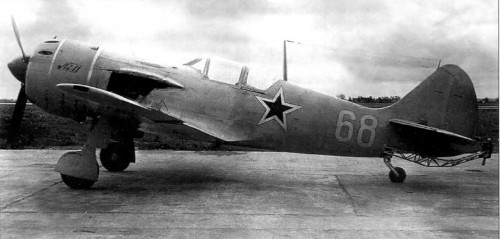 |
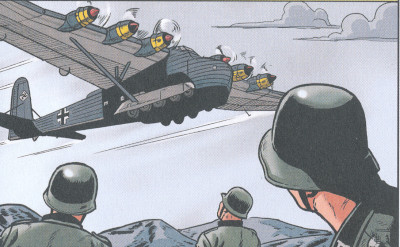 |
A WW II German heavy transport aircraft Me 323 is show in the Buck Danny Classic # 7 titled SEA DART |
The Messerschmitt Me 323 Gigant ("Giant") was a German military transport aircraft of World War II. It was a powered variant of the Me 321 military glider and was the largest land-based transport aircraft of the war. A total of 213 are recorded as having been made, 15 being converted from the Me 321.
By September 1942, Me 323s were being delivered for use in the Tunisian campaign, and entered service in the Mediterranean theater in November 1942. The high rate of loss among Axis shipping had made necessary a huge airlift of equipment across the Mediterranean to keep Rommel's Afrika Korps supplied.
On 22 April 1943, a formation of 27 fully loaded Me 323s was being escorted across the Sicilian Straits by Bf 109s of JG 27 when it was intercepted by seven squadrons of Spitfires and P-40s. Of the 27 transports, only six reached their destination; the remaining 21 of the Me 323s were lost while three of the P-40s were shot down by the escorts.
A total of 198 Me 323s were built before production ceased in April 1944. There were several production versions, beginning with the D-1. Later D- and E- versions differed in the choice of power plant and in defensive armament, with improvements in structural strength, total cargo load and fuel capacity also being implemented. Nonetheless, the Me 323 remained significantly underpowered. There was a proposal to install six BMW 801 radials, but this never came to pass. The Me 323 was also a short-range aircraft, with a typical range (loaded) of 1,000–1,200 km (620–750 mi). Despite this, the limited numbers of Me 323s in service were an asset to the Germans, and saw extensive use.
|
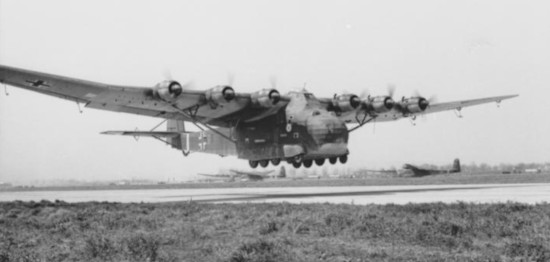 |
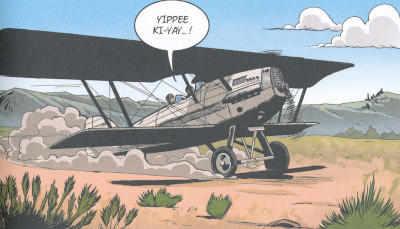 |
An old biplane Potez 25 is represented in the Buck Danny Classic # 7 titled SEA DART |
Potez 25 (also written as Potez XXV) was a French twin-seat, single-engine biplane designed during the 1920s. A multi-purpose fighter-bomber, it was designed as a line aircraft and used in a variety of roles, including fighter and escort missions, tactical bombing and reconnaissance missions. In the late 1920s and early 1930s, Potez 25 was the standard multi-purpose aircraft of over 20 air forces, including French, Polish and American. It was also popular among private operators, notably mail transport companies.
The aircraft was further developed into the 25M, a standard parasol-wing monoplane, which never entered production.
|
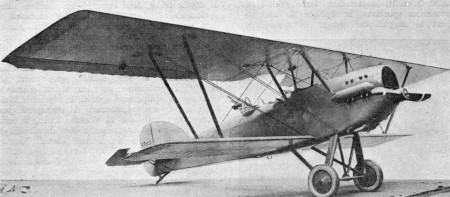 |
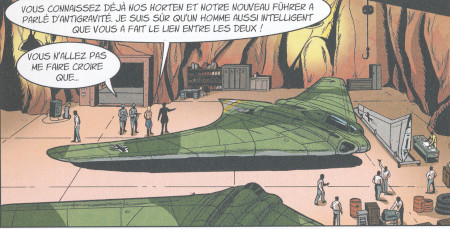 |
In the Buck Danny Classic # 8 titled LE REPAIR DE L'AIGLE In a secret Nazist base in Argentina several jet Ho 229 are tested. These flying wing jets are equipped with a fantasy anti gravity devices and in this adventure also Buck Danny and Jerry Tumbler are obligated to test in flight these innovative aircraft. |
The Horten H.IX, RLM designation Ho 229 (or Gotha Go 229 for extensive re-design work done by Gotha to prepare the aircraft for mass production) was a German prototype fighter/bomber initially designed by Reimar and Walter Horten to be built by Gothaer Waggonfabrik late in World War II. It was the first flying wing to be powered by jet engines.
The design was a response to Hermann Göring's call for light bomber designs capable of meeting the "3×1000" requirement; namely, to carry 1,000 kilograms (2,200 lb) of bombs a distance of 1,000 kilometres (620 mi) with a speed of 1,000 kilometres per hour (620 mph). Only jets could provide the speed, but these were extremely fuel-hungry, so considerable effort had to be made to meet the range requirement. Based on a flying wing, the Ho 229 lacked all extraneous control surfaces to lower drag. It was the only design to come even close to the requirements, and received Göring's approval. Its ceiling was 15,000 metres (49,000 ft).
|
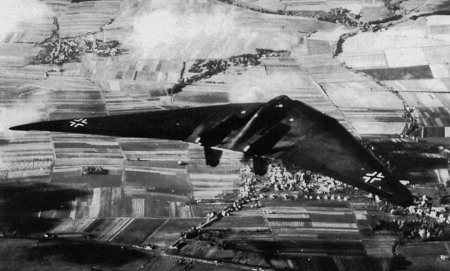 |
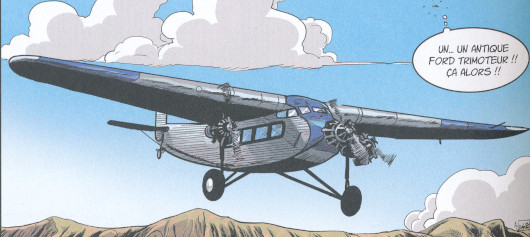 |
An old biplane Three-engined transport aircraft Ford Trimotor is represented in the Buck Danny Classic # 7 and #8 titled SEA DART and LE REPAIR DE L'AIGLE |
The Ford Trimotor (also called the "Tri-Motor", and nicknamed the "Tin Goose") is an American three-engined transport aircraft. Production started in 1925 by the companies of Henry Ford and ended on June 7, 1933. A total of 199 Ford Trimotors were made. It was designed for the civil aviation market, but also saw service with military units.
|
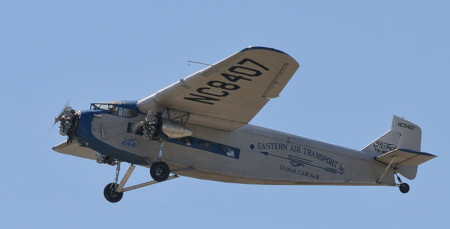 |
 |
In the story BUCK DANNY ORIGINS - LE PILOTE A L'AILE BRISEE an aviation magazine is dedicated to a young Jane Hamilton (future Lady X) who won the Bendix Trophy Race flying a P-35 |
The Seversky P-35 is an American fighter aircraft built by the Seversky Aircraft Company in the late 1930s. A contemporary of the Hawker Hurricane and Messerschmitt Bf 109, the P-35 was the first single-seat fighter in United States Army Air Corps to feature all-metal construction, retractable landing gear, and an enclosed cockpit.
|
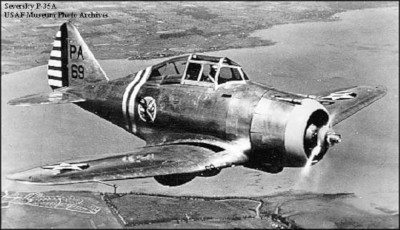 |
|
Curtiss O2C-1 (F8C) Helldiver |
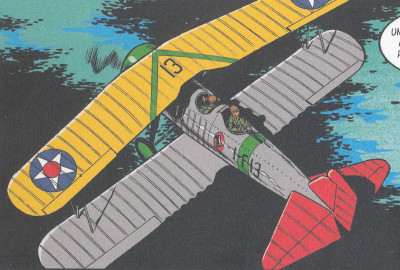 |
In the story BUCK DANNY ORIGINS - LE PILOTE A L'AILE BRISEE an old O2C-1 (F8C) Helldiver is well depicted by De Luca. |
The Curtiss O2C was the designation given to the later models of the F8C Helldiver after it was redesignated as a land based observation aircraft.
The F8C Helldiver was the first purpose-built dive bomber to be produced for the US Navy, but it only had a short service career in that role at the very start of the 1930s. When the F8C-5 ordered into production, with deliveries to start in 1931, it was seen as a land-based observation aircraft and was produced without carrier equipment. Soon after entering service the sixty three F8C-5s were redesignated as the O2C-1. Another thirty aircraft were built from new as O2C-1s, for a total of 93 aircraft.
|
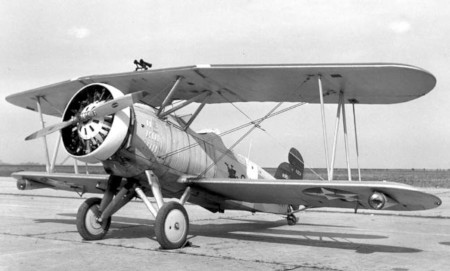 |
|
Nakajima J1N Gekko "Irving" |
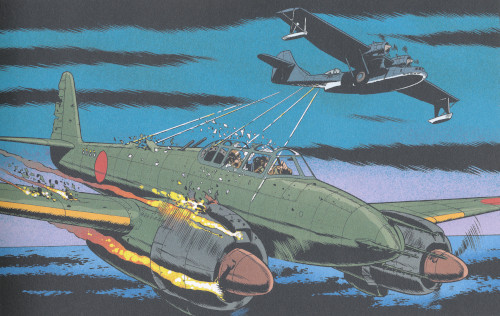 |
In the story BUCK DANNY ORIGINS - LE LE FILS DU VIKING NOIR a Japanese night fighter Nakajima J1N Gekko is well represented by De Luca. |
The Nakajima J1N1 Gekko ("Moonlight") is a twin-engine aircraft used by the Japanese Imperial Navy during World War II and was used for reconnaissance, night fighter, and kamikaze missions. The first flight took place in May 1941. It was given the Allied reporting name "Irving", since the earlier reconnaissance version the J1N1-C, was mistaken for a fighter.
|
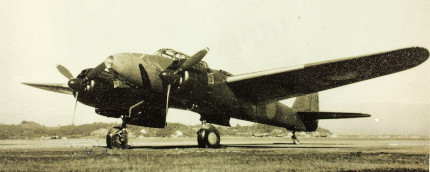 |
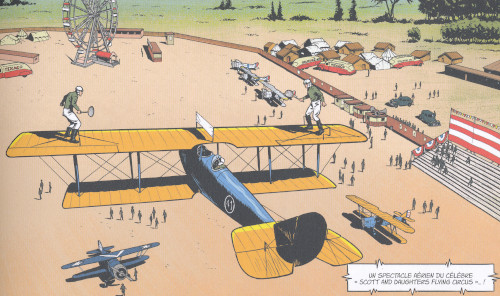 |
In the story BUCK DANNY ORIGINS - LE LE FILS DU VIKING NOIR an old biplane JN-4 Jenny used by a flying Circus is well represented by De Luca. |
An old biplane of the serie Curtiss JN was probably also shown in the story about Sonny Tukcson ORIGINS - AIR RACE PILOT. |
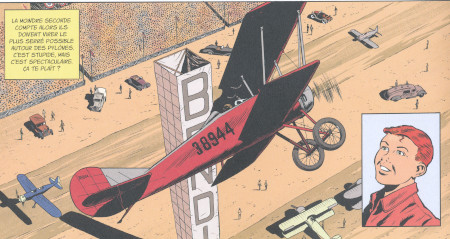 |
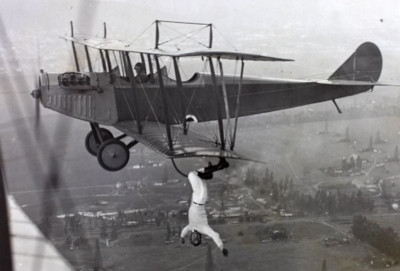 |
The Curtiss JN "Jenny" was a series of biplanes built by the Curtiss Aeroplane Company of Hammondsport, New York, later the Curtiss Aeroplane and Motor Company. Although the Curtiss JN series was originally produced as a training aircraft for the US Army, the "Jenny" (the common nickname derived from "JN") continued after World War I as a civil aircraft, as it became the "backbone of American postwar civil aviation"
|
 |
In the story BUCK DANNY ORIGINS - LE LE FILS DU VIKING NOIR what seems to be a biplane Curtiss Falcon used by a flying Circus is also represented by De Luca. |
The Curtiss Falcon was a family of military biplane aircraft built by the American aircraft manufacturer Curtiss Aeroplane and Motor Company during the 1920s. Most saw service as part of the United States Army Air Corps as observation aircraft with the designations O-1 and O-11, or as the attack aircraft designated the A-3 Falcon.
|
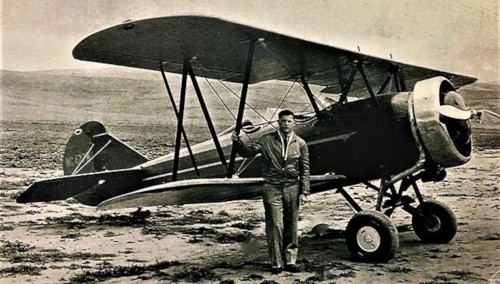 |
 |
In the story BUCK DANNY ORIGINS - LE LE FILS DU VIKING NOIR a races plane Travel Air Mystery ship used by a flying Circus is also represented by De Luca. |
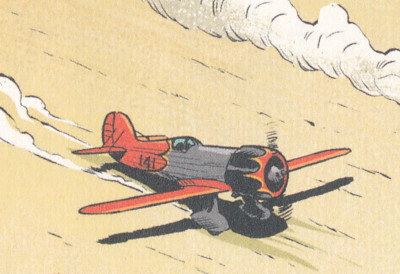 |
The races plane Travel Air Mystery ship is also represented by De Luca in the story related to origines AIR RACE PILOT. |
The Travel Air Type R "Mystery Ships" were a series of wire-braced, low-wing racing airplanes built by the Travel Air company in the late 1920s and early 1930s. They were so called, because the first aircraft of the series (R614K) was built entirely in secrecy and kept under cover prior to the 1929 Cleveland Air Races, with the builders even going so far as to fly the aircraft in at night so no one would get a look at it before the races.
|
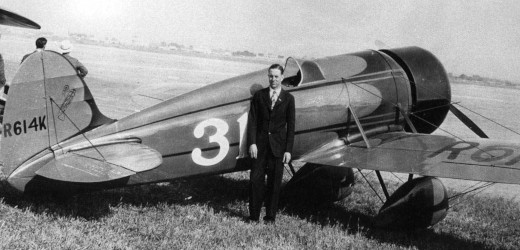 |
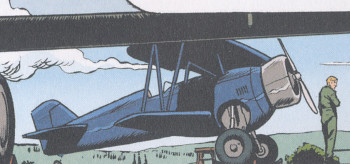 |
In the story BUCK DANNY ORIGINS - LE LE FILS DU VIKING NOIR a possible Grumman F3F is represented by De Luca. |
The Grumman F3F was a biplane fighter aircraft produced by the Grumman aircraft for the United States Navy during the mid-1930s. Designed as an improvement on the F2F, it entered service in 1936 as the last biplane to be delivered to any American military air arm. It was retired from front line squadrons at the end of 1941 before it could serve in World War II, and replaced by the Brewster F2A Buffalo. The F3F, which inherited the Leroy Grumman-designed retractable main landing gear configuration first used on the Grumman FF, served as the basis for a biplane design ultimately developed into the much more successful F4F Wildcat that succeeded the subpar Buffalo.
|
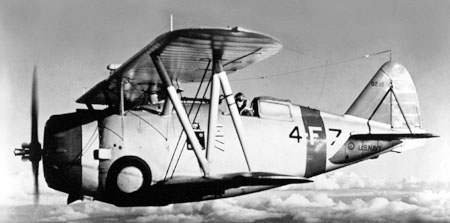 |
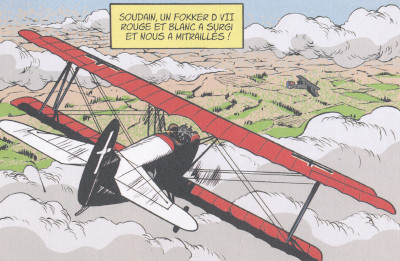 |
In the story BUCK DANNY ORIGINS - LE LE FILS DU VIKING NOIR a German WWI Fokker D.VII is flow by Walther Daneman who was Buck Danny's father. After the war he migrated in USA changing his name in Walter Danny. |
The Fokker D.VII was a German World War I fighter aircraft designed by Reinhold Platz of the Fokker-Flugzeugwerke. Germany produced around 3,300 D.VII aircraft in the second half of 1918. In service with the Luftstreitkräfte, the D.VII quickly proved itself to be a formidable aircraft. The Armistice ending the war specifically required, as the fourth clause of the "Clauses Relating to the Western Front", that Germany was required to surrender all D.VIIs to the Allies. Surviving aircraft saw much service with many countries in the years after World War I.
|
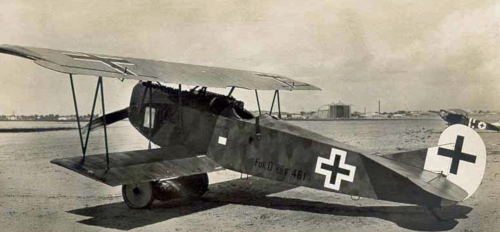 |
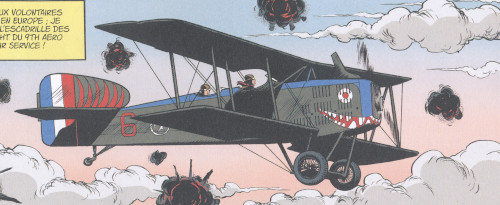 |
In the story BUCK DANNY ORIGINS - LE LE FILS DU VIKING NOIR a French WWI Breguet XIV A2 is well depicted by De Luca. |
The Bréguet XIV (in contemporary practice) or Bréguet 14 was a French biplane bomber and reconnaissance aircraft of World War I. It was built in very large numbers and production continued for many years after the end of the war.
The Bréguet 14 was among the first mass-produced aircraft to use large amounts of aluminium, rather than wood or steel, in its structure. This allowed the airframe to be both lighter and stronger, in turn making the aircraft fast and agile and it was able to outrun some contemporary fighters.
|
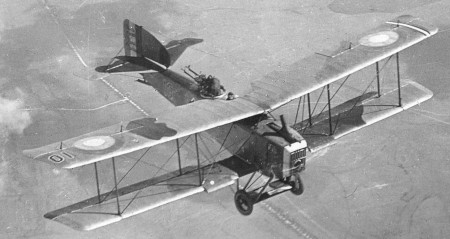 |
 |
In the story BUCK DANNY ORIGINS - LE LE FILS DU VIKING NOIR what seems to be a Fokker F-10 transport aircraft is represented by De Luca. |
The Fokker F-10 was an enlarged development of the Fokker F.VII airliner, built in the late 1920s by the Fokker Aircraft Corporation of America. A trimotor, it carried 12 passengers, four more than the F.VII, and had a larger wing and more powerful engines.
|
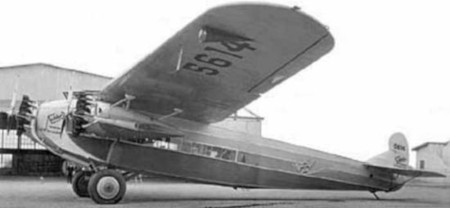 |
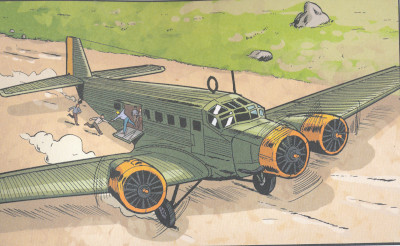 |
In the story MOLOTOK-41 NE REPOND PLUS a JU-52 is well represented by Le Bras. |
The Junkers Ju 52/3m (nicknamed Tante Ju ("Aunt Ju") and Iron Annie) is a transport aircraft that was designed and manufactured by German aviation company Junkers.
Development of the Ju 52 commenced during 1930, headed by German aeronautical engineer Ernst Zindel. The aircraft's design incorporated a corrugated duralumin metal skin as a strengthening measure, which was very unusual at the time. The Ju 52's maiden flight was performed on 13 October 1930. It was initially designed with a single engine, however, it was produced in quantity as a trimotor. The primary early production model, the Ju 52/3m, was principally operated as a 17-seat airliner or utility transport aircraft by various civil operators during the 1930s. Following the rise of Nazi Germany, thousands of Ju 52s were procured as a staple military transport of the nation. The Ju 52/3mg7e was the principal production model.
The Ju 52 was in production between 1931 and 1952.
|
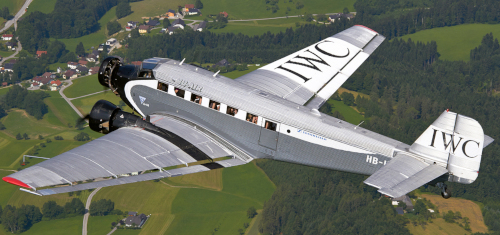 |
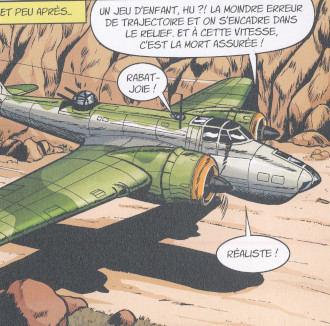 |
In the story L'OMBRE ROUGE and ATOMIC CITY a WW II Bristol Blenheim MK V used for a war movie is well represented. |
The Bristol Blenheim is a British light bomber designed and built by the Bristol Aeroplane Company, which was used extensively in the first two years of the Second World War, with examples still being used as trainers until the end of the war. Development began with the Type 142, a civil airliner, after a challenge from the newspaper proprietor Lord Rothermere to produce the fastest commercial aircraft in Europe.
The Mk V (Type 160) was used primarily in the Middle East and Far East. The Blenheim served as the basis for the Beaufort torpedo bomber, which led to the Beaufighter, with the lineage performing two evolutions of bomber-to-fighter.
|
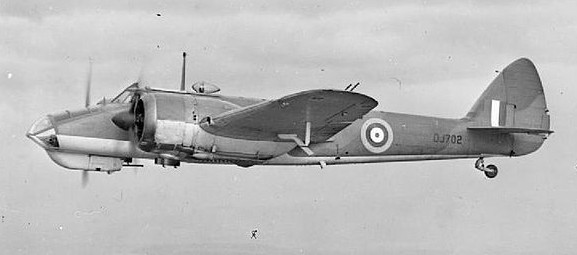 |
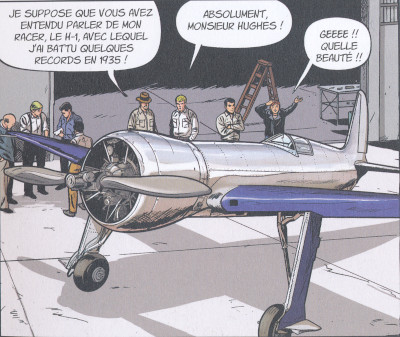 |
In the story L'OMBRE ROUGE Buck Danny is flying a Hughes H-1 Racer. |
The Hughes H-1 Racer is a racing aircraft built by Hughes Aircraft in 1935. Utilising different wings, it set both a world airspeed record and a transcontinental speed record across the United States. The H-1 Racer was the last aircraft built by a private individual to set the world speed record; most aircraft to hold the record since have been military designs.
|
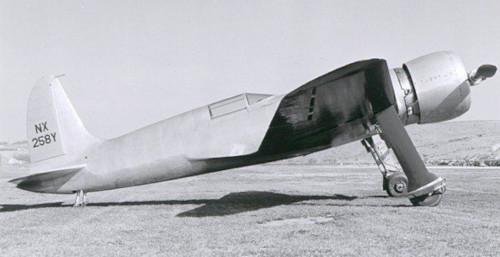 |
|
Lockheed Model 10 Electra |
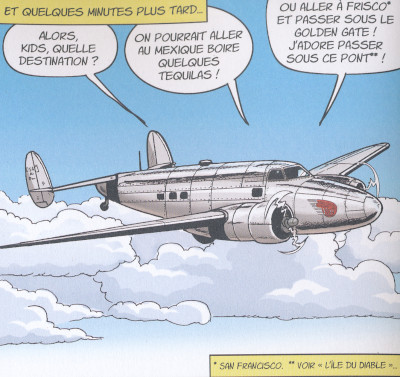 |
In the story L'OMBRE ROUGE Buck Danny and friends are flying on a Lockheed Model 10 Electra. |
The Lockheed Model 10 Electra is an American twin-engined, all-metal monoplane airliner developed by the Lockheed Aircraft Corporation, which was produced primarily in the 1930s to compete with the Boeing 247 and Douglas DC-2. The type gained considerable fame as one was flown by Amelia Earhart and Fred Noonan on their ill-fated around-the-world expedition in 1937.
|
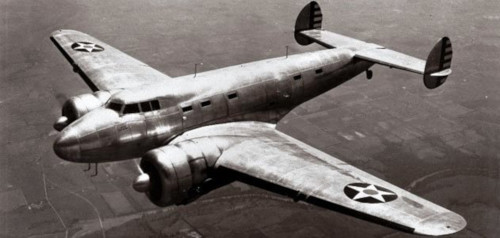 |
 |
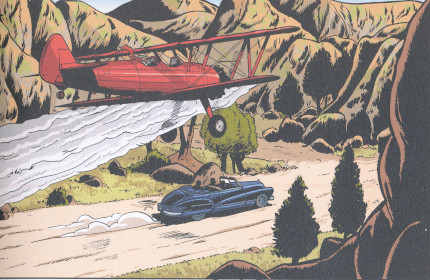 |
In the story L'OMBRE ROUGE the misterious Russian spy "Ombre Rouge" is try to kill Buck Danny and his friends sprying over them a herbicide product with a Stearman Aircraft. |
A young Sonny learn to fly with a Boeing -Steraman Model 75 in the story ORINGINES-RACE PILOT. He also use the same aircraft for some Air Race. |
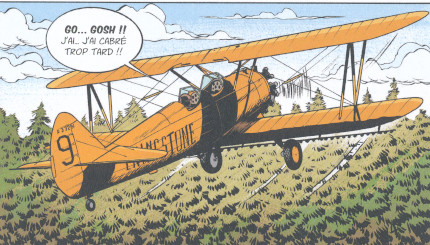 |
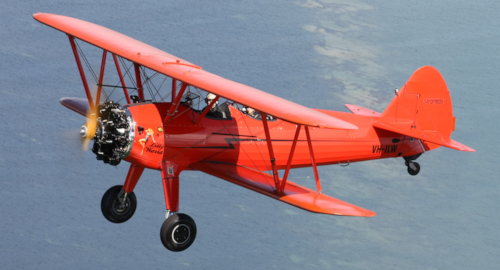 |
Stearman Aircraft Corporation was an aircraft manufacturer in Wichita, Kansas. Although the company designed a range of other aircraft, it is most known for producing the Model 75, which is commonly known simply as the "Stearman" or "Boeing Stearman".
|
 |
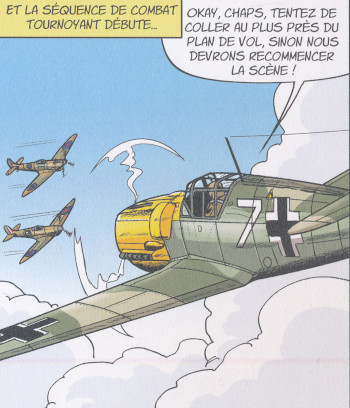 |
In the story L'OMBRE ROUGE and ATOMIC CITY a Messerschmitt Bf 109 is flying by Jerry Tumbler during a WWII movie filming. |
The Messerschmitt Bf 109 is a German World War II fighter aircraft that was, along with the Focke-Wulf Fw 190, the backbone of the Luftwaffe's fighter force. The Bf 109 first saw operational service in 1937 during the Spanish Civil War. It was still in service at the end of World War II in 1945. It was one of the most advanced fighters when it first appeared, with an all-metal monocoque construction, a closed canopy, and retractable landing gear. A liquid-cooled, inverted-V12 aero engine powered it. It was called the Me 109 by Allied aircrew and some German aces, even though this was not the official German designation.
|
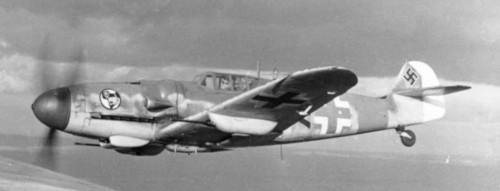 |
 |
|
Hughes H-4 Hercules "Spruce Goose" |
 |
In the story L'OMBRE ROUGE the huge seaplane Hughes H-4 Hercules "Spruce Goose" is represented by Le Bras. |
The Hughes H-4 Hercules (commonly known as the Spruce Goose; registration NX37602) is a prototype strategic airlift flying boat designed and built by the Hughes Aircraft Company. Intended as a transatlantic flight transport for use during World War II, it was not completed in time to be used in the war. The aircraft made only one brief flight, on November 2, 1947, and the project never advanced beyond the single example produced.
|
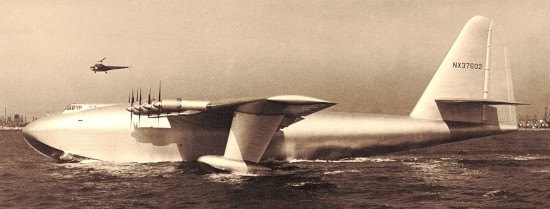 |
 |
 |
In the story L'OMBRE ROUGE the sesquiplane amphibious aircraft Sikorsky S-38 is also well represented. |
The Sikorsky S-38 was an American twin-engined ten-seat sesquiplane amphibious aircraft. It was Sikorsky's first widely produced amphibious flying boat, serving successfully for Pan American Airways and the United States military
|
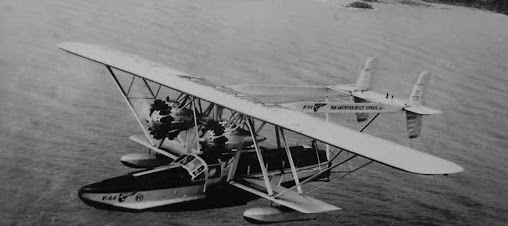 |
 |
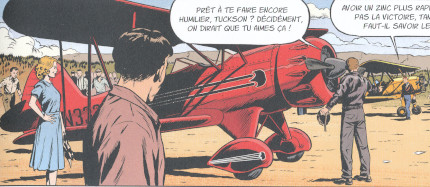 |
In the story about Sonny Tuckson ORIGINES-AIR RACE PILOT a Wako YMF-5 is well represented by De Luca. |
The Waco F series is a series of American-built general aviation and military biplane trainers of the 1930s from the Waco Aircraft Company.
The 'F' series was popular with private owner pilots for sporting and other uses and continued in production through the late 1930s. The tandem cockpit UPF-7 was adopted by the Civilian Pilot Training Program and continued in production until 1942 by which time over 600 had been built.
|
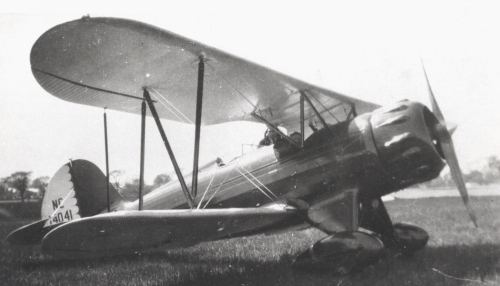 |
|
Laird-Turner Meteor LTR-14 |
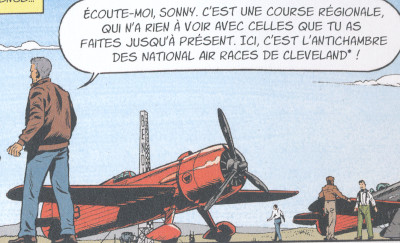 |
In the story about Sonny Tuckson ORIGINES-AIR RACE PILOT a Laird-Turner Meteor LTR-14 is well represented by De Luca. |
The Laird-Turner RT-14 Meteor, also called the Turner TR-14, Ring Free Meteor, PESCO Special, Miss Champion, Turner Special and the Turner Meteor is the winning aircraft of the 1938 and 1939 Thompson Trophy races.
The aircraft was commissioned and designed by Roscoe Turner in 1936. The Meteor would be the last of the Matty Laird race planes as well as the last race plane flown by Roscoe Turner.
|
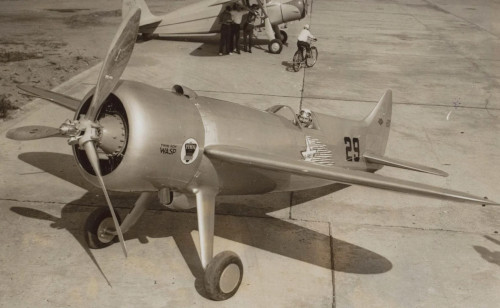 |
 |
|
Granville Gee Bee Model R Super Sportster |
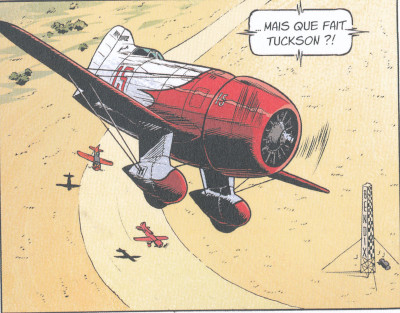 |
In the story about Sonny Tuckson ORIGINES-AIR RACE PILOT he win an important Air Race flying a Gee Bee Model R. |
The Gee Bee Model R Super Sportster was a special-purpose racing aircraft made by Granville Brothers Aircraft of Springfield, Massachusetts at the now-abandoned Springfield Airport.
The R-1 won the 1932 Thompson Trophy race, piloted by Jimmy Doolittle. He lapped all but one ship in the race, made easy turns and never had to come down and make a tight pylon turn. He also set a new F.A.I. world landplane speed record of 296 mph (476 km/h) in the Shell Speed Dash.
|
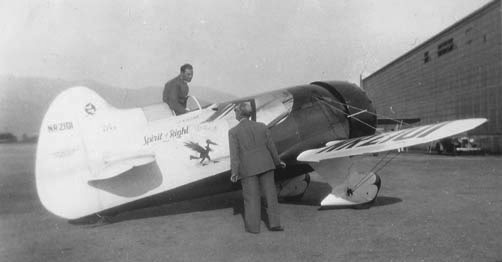 |
 |
|
Beechcraft Model 17 Staggerwing |
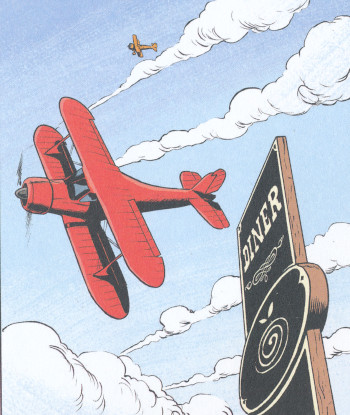 |
In the story about Sonny Tuckson ORIGINES-AIR RACE PILOT a Beechcraft Model 17 is well represented by De Luca. |
The Beechcraft Model 17 Staggerwing is an American biplane with an atypical negative wing stagger (the lower wing is farther forward than the upper wing). It first flew in 1932.
The Staggerwing's speed made it popular with 1930s air racers. An early version of the Model 17 won the 1933 Texaco Trophy Race. In 1935, a British diplomat, Capt. H.L. Farquhar, successfully flew around the world in a Model B17R, traveling 21,332 miles (34,331 kilometers) from New York to London, by way of Siberia, Southeast Asia, the Middle East, North Africa and back across Europe.
|
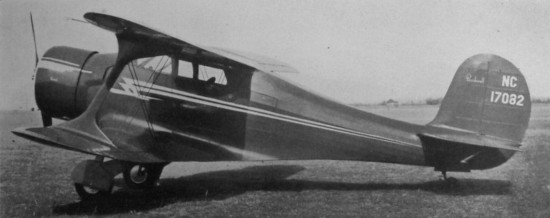 |
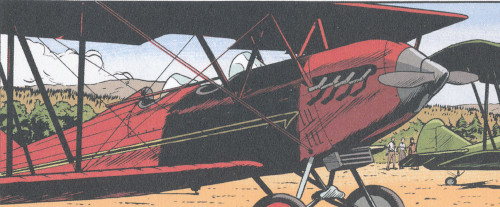 |
In the story about Sonny Tuckson ORIGINES-AIR RACE PILOT an aircraft that looks like an Hawker Nimrod is represented by De Luca. |
The Hawker Nimrod is a British carrier-based single-engine, single-seat biplane fighter aircraft built in the early 1930s by Hawker Aircraft.
After testing in 1930, the prototype went with HMS Eagle to Buenos Aires, flying there as part of the British Empire Trade Exhibition in March 1931. It returned to RAF Martlesham Heath for final testing. A production order for 35 was placed and the first of these flew on 31 October 1931. In the following year, another contract for a further 19 Nimrod Is was signed. With a top speed of 193 mph (311 km/h) it was only marginally slower than its land-based counterpart, the Hawker Fury.
|
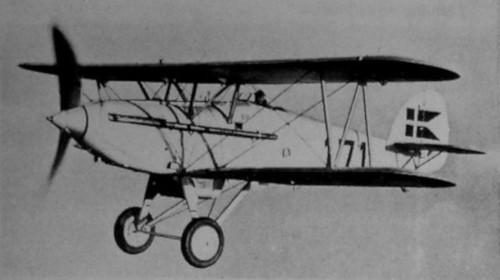 |
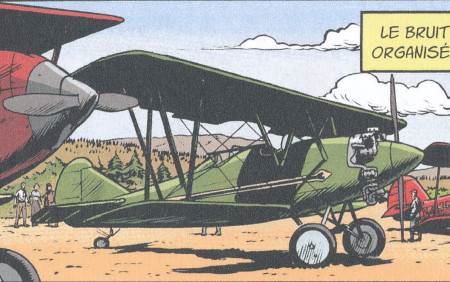 |
In the story about Sonny Tuckson ORIGINES-AIR RACE PILOT an aircraft that looks like an Hawker Tomtit is represented by De Luca. |
The Hawker Tomtit is a British training biplane from the late 1920s.
Hawker also produced five civil registered Tomtits.[1] The first two of these started with a Mongoose IIIA engine and the third with an upright in-line 115 hp (86 kW) A.D.C. Cirrus Major. It was thought that this latter, lower power engine choice might appeal more to public sporting owners. Three of these aircraft were later owned by Wolseley, who fitted them with their cowled A.R. 7 and A.R.9 radial motors.
|
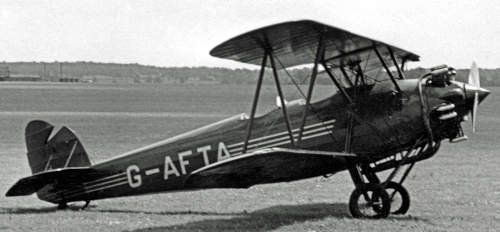 |
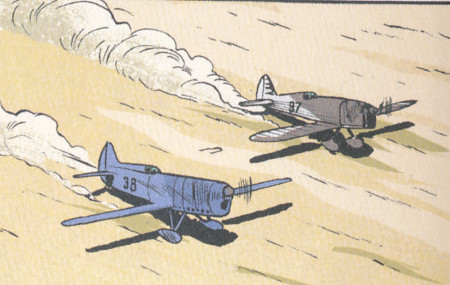 |
In the story about Sonny Tuckson ORIGINES-AIR RACE PILOT s couple of aircraft that look like an DGA-5 Ike are represented by De Luca. |
The Howard DGA-4 a.k.a. Mike, and DGA-5 a.k.a. Ike and "Miss Chevrolet" was the next in a series of racers from Ben Howard. He built two examples, "Mike" and "Ike", each with a different landing gear design.
In 1932 work started on a larger follow-on racer to Howard's "Pete" racer. Both aircraft were built to ATC design requirements for ATC racing that never came about.
The DGA-4 was a low-wing, wire braced monoplane. Ventilation came from 30 holes drilled into the windscreen
|
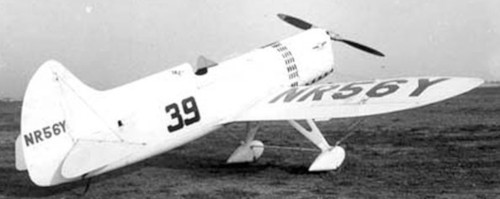 |
 |
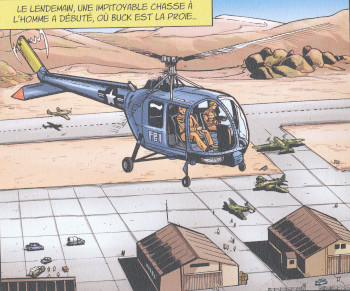 |
In the "classic" story ATOMIC CITY a Sikorsky S-52 from FBI is represented by LeBras. |
The Sikorsky S-52 is a utility helicopter developed by Sikorsky Aircraft in the late 1940s. It was used by the U.S. Navy, Marine Corps, and Coast Guard.[2] The S-52 was the first US helicopter with all-metal rotor blades. Initially a two-seater, it was developed into the four-seat S-52-2 and S-52-3. It was designated HO5S-1 by the U.S. Navy and Marine Corps, HO5S-1G by the Coast Guard, and YH-18A by the U.S. Army, and was used extensively by civil operators after being retired by the military.
|
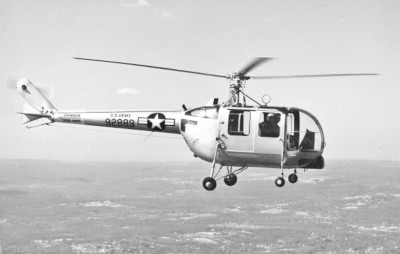 |
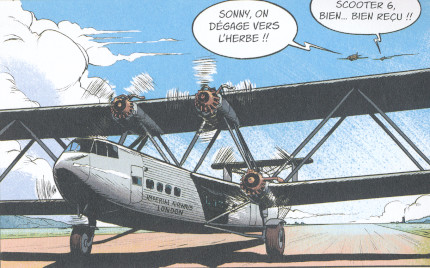 |
In the "origins" story LETTRES À JO a biplane airlainers Handley Page H.P.42 is represented by De Luca. |
The Handley Page H.P.42 and H.P.45 were four-engine biplane airliners designed and manufactured by British aviation company Handley Page, based in Radlett, Hertfordshire. They held the distinction of being the largest airliners in regular use in the world on the type's introduction in 1931.[1]
The H.P.42/45 were designed in response to a specification issued during 1928 by the British flag airline Imperial Airways. The two models are very similar, with the H.P.42 optimised for range at the expense of payload while the H.P.45 carried more passengers over shorter distances. Imperial Airways approved Handley Page's proposals and ordered four aircraft of the two variants to serve as the new land-based long-distance flagships of its fleet.
|
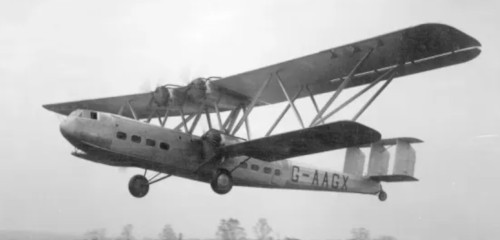 |
| |